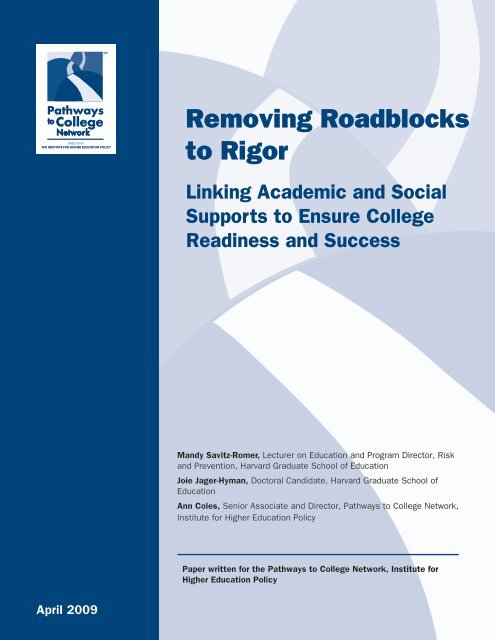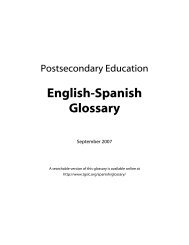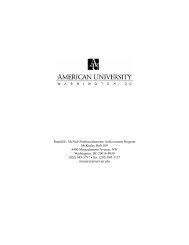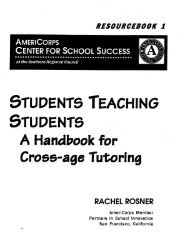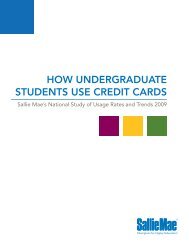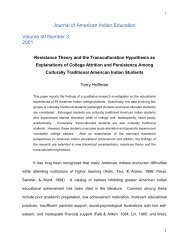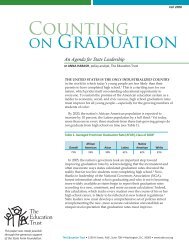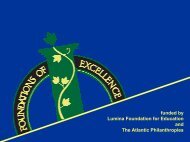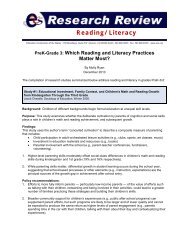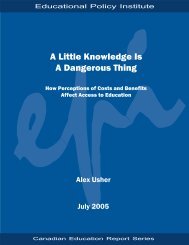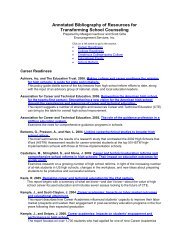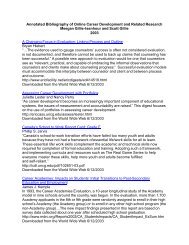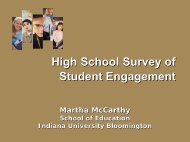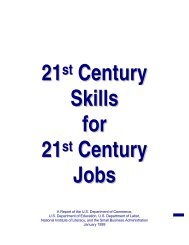Removing Roadblocks to Rigor: Linking Academic and Social ...
Removing Roadblocks to Rigor: Linking Academic and Social ...
Removing Roadblocks to Rigor: Linking Academic and Social ...
Create successful ePaper yourself
Turn your PDF publications into a flip-book with our unique Google optimized e-Paper software.
DIRECTED BY<br />
THE INSTITUTE FOR HIGHER EDUCATION POLICY<br />
<strong>Removing</strong> <strong>Roadblocks</strong><br />
<strong>to</strong> <strong>Rigor</strong><br />
<strong>Linking</strong> <strong>Academic</strong> <strong>and</strong> <strong>Social</strong><br />
Supports <strong>to</strong> Ensure College<br />
Readiness <strong>and</strong> Success<br />
M<strong>and</strong>y Savitz-Romer, Lecturer on Education <strong>and</strong> Program Direc<strong>to</strong>r, Risk<br />
<strong>and</strong> Prevention, Harvard Graduate School of Education<br />
Joie Jager-Hyman, Doc<strong>to</strong>ral C<strong>and</strong>idate, Harvard Graduate School of<br />
Education<br />
Ann Coles, Senior Associate <strong>and</strong> Direc<strong>to</strong>r, Pathways <strong>to</strong> College Network,<br />
Institute for Higher Education Policy<br />
Paper written for the Pathways <strong>to</strong> College Network, Institute for<br />
Higher Education Policy<br />
April 2009
DIRECTED BY<br />
THE INSTITUTE FOR HIGHER EDUCATION POLICY<br />
The Pathways <strong>to</strong> College Network is an alliance of over 30 national organizations that<br />
advances college opportunity for underserved students by raising public awareness,<br />
developing new research that is both innovative <strong>and</strong> actionable, <strong>and</strong> promoting<br />
evidence based policies <strong>and</strong> practices across the K-12 <strong>and</strong> higher education sec<strong>to</strong>rs.<br />
Pathways’ work focuses on the education pipeline from middle school through<br />
college graduation in four key areas: <strong>Academic</strong> Readiness for College, College<br />
Access <strong>and</strong> Information, Financial Aid <strong>and</strong> Affordability, <strong>and</strong> College Success. Our<br />
website provides a comprehensive collection of college access <strong>and</strong> success studies<br />
<strong>and</strong> other resources <strong>to</strong> inform policy, practice <strong>and</strong> research. Pathways is directed by<br />
the Institute for Higher Education Policy, a nonprofit organization in Washing<strong>to</strong>n, DC.<br />
Visit our website for more information: www.pathways<strong>to</strong>college.net.<br />
The Institute for Higher Education Policy (IHEP) is an independent, nonprofit<br />
organization that is dedicated <strong>to</strong> increasing access <strong>and</strong> success in postsecondary<br />
education around the world. Established in 1993, the Washing<strong>to</strong>n, D.C.-based<br />
organization uses unique research <strong>and</strong> innovative programs <strong>to</strong> inform key decision<br />
makers who shape public policy <strong>and</strong> support economic <strong>and</strong> social development.<br />
IHEP’s web site, www.Ihep.org, features an expansive collection of higher<br />
education information available free of charge <strong>and</strong> provides access <strong>to</strong> some of the<br />
most respected professionals in the fields of public policy <strong>and</strong> research.<br />
Pathways <strong>to</strong> College Network<br />
Institute for Higher Education Policy<br />
1320 19th St NW, Suite 400<br />
Washing<strong>to</strong>n, DC 20036<br />
(202) 861-8223<br />
(202) 861-9307 fax<br />
www.pathways<strong>to</strong>college.net<br />
www.ihep.org<br />
© 2009 Institute for Higher Education Policy
DIRECTED BY<br />
THE INSTITUTE FOR HIGHER EDUCATION POLICY<br />
<strong>Removing</strong> <strong>Roadblocks</strong><br />
<strong>to</strong> <strong>Rigor</strong><br />
<strong>Linking</strong> <strong>Academic</strong> <strong>and</strong> <strong>Social</strong><br />
Supports <strong>to</strong> Ensure College<br />
Readiness <strong>and</strong> Success<br />
M<strong>and</strong>y Savitz-Romer, Lecturer on Education <strong>and</strong> Program Direc<strong>to</strong>r, Risk<br />
<strong>and</strong> Prevention, Harvard Graduate School of Education<br />
Joie Jager-Hyman, Doc<strong>to</strong>ral C<strong>and</strong>idate, Harvard Graduate School of<br />
Education<br />
Ann Coles, Senior Associate <strong>and</strong> Direc<strong>to</strong>r, Pathways <strong>to</strong> College Network,<br />
Institute for Higher Education Policy<br />
April 2009<br />
Paper written for the Pathways <strong>to</strong> College Network, Institute for<br />
Higher Education Policy
Acknowledgements<br />
The authors wish <strong>to</strong> acknowledge the support <strong>and</strong> input provided by Cheryl Blanco, Alisa Cunningham,<br />
Monica S<strong>to</strong>ne, Lauren Weinstein, <strong>and</strong> the Pathways <strong>to</strong> College Network Steering Committee, including<br />
Rosa Aronson, Richard Arum, Julie Bell, Alma Clay<strong>to</strong>n-Pedersen, David Hawkins, Jacqueline King, Joan Lord,<br />
<strong>and</strong> Bruce V<strong>and</strong>al. Matt Wall provided valuable edi<strong>to</strong>rial assistance, <strong>and</strong> Aimee McCarron designed the<br />
report for publication. We would also like <strong>to</strong> thank TERI (The Education Resources Institute) for its support<br />
of this report.<br />
REMOVING ROADBLOCKS TO RIGOR
Table of Contents<br />
Executive Summary ................................................................................ 1<br />
Introduction ........................................................................................... 5<br />
Features of <strong>Academic</strong> <strong>Rigor</strong> ..................................................................... 7<br />
A Unifying Framework <strong>and</strong> Organizing Definition ........................................ 9<br />
Promising Policies <strong>and</strong> Practices ........................................................... 11<br />
Recommendations for Educa<strong>to</strong>rs, Policymakers, <strong>and</strong> Researchers ........... 18<br />
Conclusion .......................................................................................... 21<br />
Notes .................................................................................................. 22<br />
About the Authors ................................................................................ 24<br />
PATHWAYS TO COLLEGE NETWORK, INSTITUTE FOR HIGHER EDUCATION POLICY<br />
iii
REMOVING ROADBLOCKS TO RIGOR
Executive Summary<br />
Today’s leaders in government, higher education,<br />
secondary schools (middle <strong>and</strong> high school),<br />
<strong>and</strong> local communities are constantly seeking<br />
new ways <strong>to</strong> improve student achievement<br />
at all levels <strong>and</strong> <strong>to</strong> increase higher education<br />
attainment. To accomplish these important<br />
goals, education stakeholders have pushed <strong>to</strong><br />
increase academic rigor <strong>and</strong> set high expectations<br />
for all students. Much progress is being made<br />
in promoting academic rigor in schools <strong>and</strong><br />
raising st<strong>and</strong>ards for college degree attainment.<br />
However, less attention has been given <strong>to</strong> the<br />
academic, social, developmental, <strong>and</strong> financial<br />
needs of students that must be addressed in<br />
order for them <strong>to</strong> respond <strong>to</strong> high expectations<br />
<strong>and</strong> achieve rigorous academic st<strong>and</strong>ards.<br />
Without strategies <strong>to</strong> support students in<br />
nurturing their talents, building new skills, <strong>and</strong><br />
mastering <strong>to</strong>ugh challenges, many will be unable<br />
<strong>to</strong> meet these increased academic dem<strong>and</strong>s.<br />
The Pathways <strong>to</strong> College Network—a partnership<br />
of national organizations <strong>and</strong> funders working<br />
<strong>to</strong> improve postsecondary opportunities for<br />
underserved populations—is undertaking a<br />
national initiative <strong>to</strong> ensure that such student<br />
needs are addressed. As a first step, Pathways<br />
commissioned this paper <strong>to</strong> focus on one piece<br />
of the initiative: an underst<strong>and</strong>ing of what<br />
we mean by “academic <strong>and</strong> social support.”<br />
The paper proposes a unifying framework in<br />
which academic <strong>and</strong> social support policies<br />
<strong>and</strong> practices go h<strong>and</strong>-in-h<strong>and</strong> with increased<br />
expectations <strong>and</strong> student success. <strong>Social</strong><br />
support builds the networks, connectedness, <strong>and</strong><br />
motivation which underpin students’ willingness<br />
<strong>and</strong> capacity <strong>to</strong> take advantage of academic<br />
strategies such as tu<strong>to</strong>ring, learning communities,<br />
<strong>and</strong> other helpful policies <strong>and</strong> practices. In<br />
other words, social support provides the<br />
foundation on which students are most likely<br />
<strong>to</strong> benefit from academic support strategies.<br />
A network of academic <strong>and</strong> social supports is<br />
critical <strong>to</strong> ensure that all students—regardless<br />
of their socio-economic background or previous<br />
educational experience—have the opportunity <strong>to</strong><br />
succeed at high levels. However, conversations<br />
about academic rigor often miss the importance<br />
of providing adequate support for students <strong>to</strong><br />
meet such st<strong>and</strong>ards. A detailed underst<strong>and</strong>ing<br />
of the types of academic <strong>and</strong> social support <strong>and</strong><br />
how they work in t<strong>and</strong>em with academic st<strong>and</strong>ards<br />
must be a part of these conversations. This<br />
paper offers a broad definition of academic <strong>and</strong><br />
social support aligned with rigor, as follows:<br />
<strong>Academic</strong> <strong>and</strong> social support comprises<br />
intentional strategies that enable students<br />
at all levels <strong>to</strong> benefit from academically<br />
rigorous curricula. These strategies are<br />
interrelated, developmentally appropriate,<br />
<strong>and</strong> provide integrated, coordinated, <strong>and</strong><br />
comprehensive support in order <strong>to</strong> improve<br />
student achievement. <strong>Academic</strong> <strong>and</strong> social<br />
support strategies fall in<strong>to</strong> one or more of the<br />
following categories: emotional, informational,<br />
instrumental, appraisal, <strong>and</strong> structural.<br />
Adapted from a previous typology<br />
developed by House 1 , these categories<br />
are not mutually exclusive <strong>and</strong> reflect the<br />
interdependent dynamics of an integrated<br />
concept of academic <strong>and</strong> social support.<br />
PATHWAYS TO COLLEGE NETWORK, INSTITUTE FOR HIGHER EDUCATION POLICY 1
Executive Summary<br />
There are numerous, specific examples of<br />
support strategies in schools <strong>and</strong> higher<br />
education institutions that illustrate the<br />
various aspects of academic <strong>and</strong> social<br />
support included in this definitition. While it is<br />
helpful <strong>to</strong> categorize these examples in order<br />
<strong>to</strong> best inform policies <strong>and</strong> practices, many<br />
of them fall in<strong>to</strong> more than one category.<br />
Emotional support<br />
Emotional support fosters self-esteem <strong>and</strong> trust<br />
by providing students with empathy, caring,<br />
love, respect, concern, <strong>and</strong> a willingness <strong>to</strong><br />
listen. Examples of emotional support include:<br />
• Individual counseling<br />
• Group <strong>and</strong> peer support<br />
• Men<strong>to</strong>ring<br />
• <strong>Social</strong>-emotional st<strong>and</strong>ards<br />
• Proactive advising<br />
• Activities that develop strong, supportive<br />
interpersonal connections among students,<br />
parents, faculty, <strong>and</strong> school staff<br />
Instrumental support<br />
Instrumental support is perhaps the most “active”<br />
type of support. This category encompasses<br />
specific behaviors that help students reach<br />
a particular outcome or goal, including giving<br />
students the chance <strong>to</strong> spend time with a caring<br />
adult, as well as providing them with in-kind or<br />
monetary support, or other types of direct help.<br />
Examples of instrumental support include:<br />
• Workshops that teach study skills, financial<br />
literacy, test-taking strategies, time<br />
management, critical reading, career<br />
exploration, organization, <strong>and</strong> planning skills<br />
• Summer transition programs – middle <strong>to</strong> high<br />
school, high school <strong>to</strong> college, two-year <strong>to</strong><br />
four-year colleges, undergraduate <strong>to</strong><br />
graduate school<br />
• Tu<strong>to</strong>ring programs, on-line tu<strong>to</strong>rials, math,<br />
<strong>and</strong> writing centers<br />
• Supplemental course instruction <strong>to</strong> improve<br />
students’ academic performance<br />
• Developmental guidance curricula<br />
• Offering college credit courses for high<br />
school students (IB, AP, dual enrollment)<br />
• State <strong>and</strong> national career development<br />
st<strong>and</strong>ards<br />
• Need-based financial aid<br />
• ACT/SAT/AP/IB test fee waivers<br />
• Admissions test preparation<br />
Informational support<br />
Informational support refers <strong>to</strong> an exchange<br />
of information that can help students meet<br />
academic goals by providing them with advice,<br />
suggestions, directives, <strong>and</strong> information.<br />
Examples of informational support include:<br />
• Education plans for achieving college goals<br />
• Advisories focused on preparing for future<br />
options <strong>and</strong> success<br />
• Freshman orientation programs, success<br />
seminars<br />
• <strong>Academic</strong> advising<br />
• Job shadowing <strong>and</strong> internships<br />
• Guidance with college admission <strong>and</strong><br />
financial aid application process<br />
• College planning <strong>and</strong> financial aid information<br />
for parents<br />
• Career exploration <strong>and</strong> placement services<br />
• Early college awareness programs, campus<br />
visits<br />
Appraisal support<br />
Appraisal support involves the transfer of<br />
information derived through assessment;<br />
it provides affirmation, feedback, social<br />
comparison, <strong>and</strong> facilitates self-evaluation.<br />
Examples of appraisal support include:<br />
• Assessments of student progress <strong>to</strong>ward<br />
meeting academic st<strong>and</strong>ards that trigger<br />
support for struggling students<br />
• PSAT, ACT’s PLAN, Accuplacer, WorkKeys,<br />
<strong>and</strong> the Collegiate Learning Assessment <strong>to</strong><br />
identify students’ academic strengths <strong>and</strong><br />
needs<br />
• Data systems <strong>to</strong> help moni<strong>to</strong>r student<br />
performance<br />
• Early warning systems with mid-term reports<br />
sent <strong>to</strong> parents<br />
2<br />
REMOVING ROADBLOCKS TO RIGOR
Executive Summary<br />
• Mid-semester progress reports sent <strong>to</strong><br />
students <strong>and</strong> their academic advisors<br />
• Early subject area testing program <strong>to</strong><br />
identify students with potential for AP/IB<br />
participation<br />
• Activities that recognize academic<br />
achievement<br />
Structural support<br />
Structural support reflects formal <strong>and</strong> informal<br />
structures that embed support in<strong>to</strong> social<br />
institutions or programs. These structures<br />
foster positive outcomes for students, such<br />
as community <strong>and</strong> school engagement, selfconfidence,<br />
resiliency, social networking,<br />
internal motivation, <strong>and</strong> academic achievement.<br />
Examples of structural support include:<br />
• Full service schools<br />
• Student support services aligned with<br />
educational instruction<br />
• Culturally relevant practices <strong>and</strong> strategies<br />
• Learning centers that provide tu<strong>to</strong>ring,<br />
skill-building, <strong>and</strong> other academic support<br />
• Ninth grade academies <strong>and</strong> first-year college<br />
programs<br />
• Small learning communities<br />
• College-going culture in middle <strong>and</strong> high<br />
schools<br />
• Strong partnerships between academic <strong>and</strong><br />
student services offices<br />
• Offices of postsecondary planning <strong>and</strong><br />
support<br />
• Dropout prevention <strong>and</strong> recovery programs<br />
skills, knowledge, <strong>and</strong> abilities necessary for<br />
them <strong>to</strong> realize their hopes <strong>and</strong> dreams.<br />
Recommendations for school <strong>and</strong> higher<br />
education leaders <strong>and</strong> policy-makers who<br />
wish <strong>to</strong> implement research-based academic<br />
<strong>and</strong> social support strategies incude:<br />
• Integrate <strong>and</strong> coordinate academic <strong>and</strong> social<br />
support strategies focused on enabling<br />
students <strong>to</strong> meet rigorous academic<br />
st<strong>and</strong>ards.<br />
• Enhance training <strong>and</strong> make more efficient<br />
use of school counselors <strong>and</strong> college support<br />
services staff, especially those who work<br />
with underserved students.<br />
• Infuse principles of adolescent development<br />
in<strong>to</strong> training programs for teachers,<br />
principals, <strong>and</strong> higher education faculty<br />
professional development programs.<br />
• Provide more incentives for secondary<br />
teachers <strong>and</strong> postsecondary faculty <strong>to</strong><br />
engage with students in meaningful ways.<br />
• Make timely, frequent assessments a priority<br />
so that secondary school teachers, college<br />
faculty, <strong>and</strong> support staff can identify <strong>and</strong><br />
address academic problems <strong>to</strong> help students<br />
early on.<br />
• Pay special attention <strong>to</strong> institutional context<br />
<strong>and</strong> how social relationships within<br />
institutions foster emotional support <strong>and</strong><br />
academic achievement.<br />
Recommendations for Educa<strong>to</strong>rs<br />
<strong>and</strong> Policymakers<br />
Ultimately, policies <strong>and</strong> practices that integrate<br />
a range of support strategies hold the most<br />
promise for increasing student achievement<br />
<strong>and</strong> success. Students need a network of<br />
individuals <strong>and</strong> resources embracing multiple<br />
strategies <strong>to</strong> provide them with effective<br />
academic <strong>and</strong> social supports. By fostering selfconfidence,<br />
resiliency, <strong>and</strong> internal motivation,<br />
social support creates the conditions that<br />
allow students <strong>to</strong> take advantage of effective<br />
academic support strategies <strong>and</strong> develop the<br />
PATHWAYS TO COLLEGE NETWORK, INSTITUTE FOR HIGHER EDUCATION POLICY<br />
3
4<br />
REMOVING ROADBLOCKS TO RIGOR
Introduction<br />
Most scholars, practitioners, <strong>and</strong> policymakers<br />
in education agree that rigorous academic<br />
preparation is essential for <strong>to</strong>day’s young people<br />
<strong>to</strong> meet the dem<strong>and</strong>s of 21 st century life <strong>and</strong><br />
careers. Unfortunately, the present reality is that<br />
far <strong>to</strong>o many students falter at various stages<br />
along the “education pipeline” from middle <strong>and</strong><br />
high school through college. One-third of all<br />
ninth-graders in the United States do not finish<br />
high school in four years. Only 60 percent of<br />
high school graduates go <strong>to</strong> college full-time<br />
the following fall, <strong>and</strong> about one-fifth of these<br />
students earn associate’s degrees in three years<br />
or bachelor’s degrees in six years. 2 Many of<br />
those who drop out along the way are students<br />
who are underserved by the nation’s education<br />
system, including low-income students, underrepresented<br />
minorities, those who are the first<br />
generation in their families <strong>to</strong> go <strong>to</strong> college, <strong>and</strong><br />
students with disabilities.<br />
Leaders in government, higher education,<br />
secondary schools (middle <strong>and</strong> high schools),<br />
<strong>and</strong> local communities have sought new ways <strong>to</strong><br />
improve student achievement at all levels <strong>and</strong><br />
<strong>to</strong> increase higher education attainment. To<br />
accomplish these important goals, education<br />
stakeholders have pushed <strong>to</strong> increase academic<br />
rigor <strong>and</strong> set high expectations for all students.<br />
Much progress is being made in promoting<br />
academic rigor in schools <strong>and</strong> raising st<strong>and</strong>ards<br />
for college degree attainment. However, less<br />
attention has been paid <strong>to</strong> the academic,<br />
social, developmental, <strong>and</strong> financial needs of<br />
students that must be addressed in order for<br />
students <strong>to</strong> respond <strong>to</strong> high expectations <strong>and</strong> <strong>to</strong><br />
achieve rigorous academic st<strong>and</strong>ards. Without<br />
strategies <strong>to</strong> support students in nurturing their<br />
talents, practicing new skills, <strong>and</strong> mastering<br />
<strong>to</strong>ugh challenges, many will be unable <strong>to</strong> meet<br />
increased academic dem<strong>and</strong>s.<br />
Concerned about the lack of focus on students’<br />
needs for support in order <strong>to</strong> meet rigorous<br />
academic st<strong>and</strong>ards at the secondary <strong>and</strong><br />
postsecondary levels, the Pathways <strong>to</strong> College<br />
Network—a partnership of national organizations<br />
<strong>and</strong> funders working <strong>to</strong> improve postsecondary<br />
opportunities for underserved populations—is<br />
undertaking a national initiative <strong>to</strong> ensure that<br />
such student needs are addressed. The initiative<br />
will engage policymakers <strong>and</strong> education leaders in<br />
providing academic, social, <strong>and</strong> financial support<br />
as a major strategy <strong>to</strong> increase the numbers of<br />
underserved students graduating from high school<br />
college-ready <strong>and</strong> completing college degrees. As<br />
a first step in this effort, Pathways commissioned<br />
a paper <strong>to</strong> focus on one piece of this initiative:<br />
an underst<strong>and</strong>ing of what we mean by “academic<br />
<strong>and</strong> social support” that enables students from<br />
economically <strong>and</strong> educationally disadvantaged<br />
backgrounds <strong>to</strong> succeed in academically rigorous<br />
programs.<br />
This paper offers a unifying framework in<br />
which academic <strong>and</strong> social support policies<br />
<strong>and</strong> practices go h<strong>and</strong>-in-h<strong>and</strong> with increased<br />
expectations <strong>and</strong> student success. i It proposes<br />
i<br />
Though financial support is beyond the scope of this paper,<br />
it is important <strong>to</strong> emphasize the success of all curricular<br />
improvements <strong>and</strong> support strategies rest on the availability<br />
of adequate financial resources <strong>to</strong> cover college costs.<br />
Additional research is necessary <strong>to</strong> explore the fundamental<br />
relationship among financial, social, <strong>and</strong> academic support<br />
strategies <strong>to</strong> help students meet high academic st<strong>and</strong>ards<br />
throughout the educational pipeline.<br />
PATHWAYS TO COLLEGE NETWORK, INSTITUTE FOR HIGHER EDUCATION POLICY 5
Introduction<br />
a broad definition of integrated academic <strong>and</strong><br />
social support that helps all students meet the<br />
dem<strong>and</strong>s of rigorous academic curricula. To inform<br />
policies <strong>and</strong> practices, the paper also provides<br />
examples of effective academic <strong>and</strong> social<br />
support strategies at both the secondary <strong>and</strong><br />
postsecondary levels.<br />
What is academic <strong>and</strong> social support? Most<br />
discussions of academic <strong>and</strong> social support<br />
suggest that they are two separate constructs,<br />
usually offered—<strong>and</strong> perhaps experienced—<br />
independently of one another.<br />
• <strong>Academic</strong> support typically refers <strong>to</strong> the<br />
formal <strong>and</strong> informal strategies that build,<br />
strengthen, <strong>and</strong> promote students’ mastery<br />
of subject matter <strong>and</strong> skill development<br />
through deliberate activities, structures,<br />
policies, <strong>and</strong> expectations.<br />
• <strong>Social</strong> support consists of strategies that<br />
foster <strong>and</strong> fortify social networks, schoolconnectedness,<br />
self-confidence, <strong>and</strong><br />
academic motivation through intentional<br />
services, behaviors, structures, <strong>and</strong><br />
expectations.<br />
This paper takes a more unitary approach <strong>to</strong><br />
the concept of academic <strong>and</strong> social supports<br />
<strong>and</strong> offers an integrated definition that attempts<br />
<strong>to</strong> capture their dynamic interaction. <strong>Social</strong><br />
support builds the networks, connectedness, <strong>and</strong><br />
motivation which underpin students’ willingness<br />
<strong>and</strong> capacity <strong>to</strong> take advantage of academic<br />
strategies such as tu<strong>to</strong>ring, learning communities,<br />
<strong>and</strong> other helpful policies <strong>and</strong> practices. In other<br />
words, social support provides the foundation<br />
on which students are most likely <strong>to</strong> benefit from<br />
academic support strategies.<br />
fail <strong>to</strong> take in<strong>to</strong> account the developmental<br />
experience of children, adolescents, <strong>and</strong><br />
young adults. Programs that incorporate the<br />
fundamentals of youth development promote<br />
the physical, psychological, social <strong>and</strong> cognitive<br />
competencies that facilitate a healthy transition <strong>to</strong><br />
adulthood.<br />
The academic <strong>and</strong> social support framework<br />
presented in this paper is a broad continuum,<br />
along which schools <strong>and</strong> higher education<br />
institutions have a signal opportunity <strong>to</strong> provide<br />
students at all educational levels the kind of<br />
academic <strong>and</strong> social support that best meets<br />
their developmental needs. To provide context<br />
for this framework, the paper uses research from<br />
multiple fields, including education, sociology,<br />
<strong>and</strong> psychology published in peer-reviewed<br />
journals, major policy reports, public opinion<br />
surveys, <strong>and</strong> other seminal work over the past<br />
15 years. ii The first section reviews features of<br />
academic rigor as described in the research on<br />
college readiness <strong>and</strong> postsecondary learning<br />
engagement <strong>and</strong> success. The second section<br />
introduces an integrated definition of academic<br />
<strong>and</strong> social support <strong>to</strong> clarify what is meant by<br />
this concept. Then, <strong>to</strong> illustrate the concept in a<br />
more concrete way, the paper outlines promising<br />
policies <strong>and</strong> practices found in secondary<br />
schools <strong>and</strong> postsecondary institutions that<br />
can help high school <strong>and</strong> college students meet<br />
rigorous academic st<strong>and</strong>ards. Finally, the last<br />
section provides specific recommendations for<br />
practitioners <strong>and</strong> other stakeholders.<br />
ii<br />
A complete annotated bibliography of research reviewed<br />
for this paper is available online at the Pathways <strong>to</strong><br />
College Network’s website (www.pathways<strong>to</strong>college.net).<br />
An important element of this unifying framework<br />
of academic <strong>and</strong> social support is the notion that<br />
effective support strategies should incorporate<br />
the principles of youth development. Though we<br />
all know that fifth graders, twelfth graders, <strong>and</strong><br />
college sophomores have very different academic<br />
<strong>and</strong> social needs, many education reform efforts<br />
6<br />
REMOVING ROADBLOCKS TO RIGOR
Features of <strong>Academic</strong> <strong>Rigor</strong><br />
The importance of rigorous academic learning<br />
experiences <strong>to</strong> prime students for future success<br />
is well documented. Common features of<br />
academic rigor include emphasizing vertical<br />
course alignment from pre-school through college;<br />
instituting a systemic, rigorous college-prepara<strong>to</strong>ry<br />
curriculum; promoting skills <strong>and</strong> habits that<br />
enable success in college <strong>and</strong> work; including<br />
assessment as part of a rigorous curriculum;<br />
<strong>and</strong> requiring students <strong>to</strong> complete challenging<br />
academic requirements.<br />
Vertical alignment of courses<br />
An important aspect of academic rigor is the need<br />
for the vertical alignment of courses from preschool<br />
through college (P-16) so that completion<br />
of a course signifies students have mastered<br />
the content <strong>and</strong> skills they need <strong>to</strong> succeed<br />
at the next level in a subject or discipline.<br />
Curricular alignment is especially critical<br />
given that communication <strong>and</strong> collaboration<br />
across elementary, middle, <strong>and</strong> high schools<br />
or between postsecondary institutions <strong>and</strong> K-<br />
12 education are not pervasive features of the<br />
American education system. 3 This shortcoming<br />
of our overall P-16 system is underscored by<br />
findings from an extensive survey indicating that<br />
postsecondary instruc<strong>to</strong>rs have far more specific<br />
expectations for college-prepara<strong>to</strong>ry coursework<br />
than high school teachers seem <strong>to</strong> identify as<br />
critical <strong>to</strong> their students’ college-readiness. 4 This<br />
apparent gap in expectations may help <strong>to</strong> explain<br />
why so many students are inadequately prepared<br />
for the academic dem<strong>and</strong>s of higher education:<br />
approximately 43 percent of students at two-year<br />
colleges <strong>and</strong> 29 percent of students at four-year<br />
colleges are placed in remedial courses upon<br />
enrolling in postsecondary institutions. 5<br />
Curriculum content<br />
There is fairly broad consensus as <strong>to</strong> which<br />
specific courses should be included in a rigorous<br />
college-prepara<strong>to</strong>ry curriculum. A high school<br />
course pattern defined as “rigorous” by numerous<br />
organizations—including High Schools That Work,<br />
the College Board, <strong>and</strong> ACT—calls for: four years<br />
of English; three years of social studies; four<br />
years of math, including geometry, Algebra I <strong>and</strong><br />
II, <strong>and</strong> preferably at least one other advanced<br />
mathematics course, such as trigonometry, precalculus,<br />
calculus, or statistics; three years of<br />
labora<strong>to</strong>ry science, including biology, chemistry<br />
<strong>and</strong> physics; <strong>and</strong> two years of foreign language.<br />
Analysis of transcripts <strong>and</strong> other data from the<br />
National Education Longitudinal Study found<br />
that students who progressed beyond Algebra II<br />
in high school had greater momentum <strong>to</strong>wards<br />
bachelor degree attainment than their peers. In<br />
addition, students who participate in certain<br />
gateway courses may significantly increase<br />
the probability of earning college degrees. For<br />
example, students who complete American<br />
Literature are six times more likely <strong>to</strong> finish<br />
college, students who take general chemistry are<br />
four times more likely, <strong>and</strong> those who complete<br />
pre-calculus, micro/macroeconomics, introduction<br />
<strong>to</strong> philosophy, or world civilization are more<br />
than three times as likely <strong>to</strong> graduate from a<br />
postsecondary institution than their peers who did<br />
not participate in these courses. 6<br />
Acquiring skills <strong>and</strong> knowledge<br />
Despite the emerging consensus on what<br />
constitutes a college-prepara<strong>to</strong>ry curriculum,<br />
course completion alone does not necessarily<br />
PATHWAYS TO COLLEGE NETWORK, INSTITUTE FOR HIGHER EDUCATION POLICY 7
Features of <strong>Academic</strong> <strong>Rigor</strong><br />
signify the mastery of certain subjects <strong>and</strong>/or<br />
acquisition of particular skills. Some advocates<br />
emphasize a primary focus on the acquisition<br />
of skills, knowledge, <strong>and</strong> habits leading <strong>to</strong><br />
college <strong>and</strong> argue that academic rigor should<br />
be defined as the degree <strong>to</strong> which students are<br />
ready <strong>to</strong> succeed in college <strong>and</strong> work. 7 In 2003,<br />
the St<strong>and</strong>ards for Success project developed<br />
a comprehensive set of college-readiness<br />
st<strong>and</strong>ards in six subject areas, focusing on<br />
the knowledge, skills, <strong>and</strong> cognitive strategies<br />
necessary for college-level success in these<br />
academic disciplines. 8 This project hypothesized<br />
that college-readiness has four facets: contextual<br />
skills <strong>and</strong> awareness; academic behaviors; key<br />
content; <strong>and</strong> key cognitive strategies. 9 Secondary<br />
school academic requirements that emphasize<br />
college-readiness have been embraced by some<br />
states in recent years. For example, Rhode Isl<strong>and</strong><br />
has instituted performance-based graduation<br />
requirements that measure competencies, skills,<br />
<strong>and</strong> curricular knowledge instead of course<br />
completion. 10<br />
On the postsecondary level, several national<br />
organizations are working with higher education<br />
institutions <strong>to</strong> adopt rigorous st<strong>and</strong>ards for<br />
student learning outcomes in undergraduate<br />
majors, <strong>and</strong> in the areas of intellectual <strong>and</strong><br />
practical skills, knowledge of human cultures<br />
<strong>and</strong> the physical <strong>and</strong> natural world, <strong>and</strong> personal<br />
social responsibility. 11 For example, the National<br />
Forum on College-Level Learning piloted the use<br />
of statewide assessments of student learning<br />
outcomes across public four-year higher education<br />
institutions <strong>to</strong> give policymakers a concrete sense<br />
of how well institutions were serving various<br />
groups <strong>and</strong> regions. By focusing on collegelevel<br />
learning, this information can also help<br />
policymakers track the degree <strong>to</strong> which students<br />
are being well-trained in professions that serve<br />
the state’s welfare.<br />
Assessment<br />
Assessment is a key feature of a rigorous<br />
academic program. Constructive <strong>and</strong> consistent<br />
feedback allows students <strong>to</strong> moni<strong>to</strong>r how well they<br />
are doing <strong>and</strong> gauge how much they still need <strong>to</strong><br />
learn. Teachers also benefit from assessments<br />
that moni<strong>to</strong>r student progress <strong>and</strong> indicate the<br />
effectiveness of various teaching approaches,<br />
<strong>and</strong> school districts <strong>and</strong> postsecondary<br />
institutions can use data gleaned from<br />
assessments <strong>to</strong> moni<strong>to</strong>r academic progress on<br />
a larger scale <strong>and</strong> identify patterns <strong>and</strong>/or gaps<br />
in achievement among groups of students. In<br />
addition, assessment data at the secondary <strong>and</strong><br />
postsecondary levels can be used <strong>to</strong> create “early<br />
warning systems” that identify students who—<br />
based on key indica<strong>to</strong>rs like test scores, grades,<br />
<strong>and</strong> attendance—may be at risk of dropping out.<br />
Requiring challenging courses<br />
Policy-related research on academic rigor<br />
calls attention <strong>to</strong> the importance of holding<br />
all students <strong>to</strong> high st<strong>and</strong>ards rather than<br />
allowing some students <strong>to</strong> progress through high<br />
school <strong>and</strong> higher education without mastering<br />
difficult academic work. Some argue that<br />
state policymakers should require completion<br />
of rigorous courses for high school graduation<br />
statewide, with students allowed <strong>to</strong> opt out only<br />
with parental consent. This position is predicated<br />
on the belief that all or most students can<br />
meet high academic expectations if given the<br />
opportunity <strong>to</strong> learn.<br />
Each of these aspects of rigor speaks <strong>to</strong> the<br />
importance of policies <strong>and</strong> practices that<br />
emphasize high academic achievement in<br />
both secondary school <strong>and</strong> college. However,<br />
conversations about rigor often miss the crucial<br />
importance of providing adequate support for<br />
students <strong>to</strong> meet such st<strong>and</strong>ards. A network of<br />
academic <strong>and</strong> social supports is critical <strong>to</strong> ensure<br />
that all students—regardless of their socioeconomic<br />
background or previous educational<br />
experience—have the opportunity <strong>to</strong> succeed<br />
at high levels. The following section explores<br />
the relationship between academic <strong>and</strong> social<br />
supports, proposes a unifying framework with<br />
five categories of academic <strong>and</strong> social support<br />
strategies, <strong>and</strong> offers an organizing definition for<br />
an integrated concept of academic <strong>and</strong> social<br />
support aligned with academic rigor.<br />
8<br />
REMOVING ROADBLOCKS TO RIGOR
A Unifying Framework <strong>and</strong><br />
Organizing Definition<br />
As noted earlier, most discussions of academic<br />
<strong>and</strong> social support categorize these strategies<br />
as separate entities, suggesting that such<br />
supports are commonly delivered <strong>and</strong> experienced<br />
independently of one another. In practice,<br />
however, academic <strong>and</strong> social supports are<br />
interrelated, intertwined, <strong>and</strong> experienced<br />
simultaneously. For example, one study of<br />
students <strong>and</strong> teachers in Chicago middle schools<br />
found that social support fosters academic<br />
motivation, builds confidence, <strong>and</strong> makes<br />
academic achievement attainable. Using Chicago<br />
Public Schools’ data, researchers observed a<br />
positive relationship among strong social support,<br />
academically challenging work, <strong>and</strong> increased test<br />
scores. This suggests that social support builds<br />
psychological comfort that allows students <strong>to</strong> take<br />
risks, admit errors, ask for help, <strong>and</strong> learn from<br />
setbacks along the way <strong>to</strong> educational success. 12<br />
An important component of the proposed<br />
definition is the notion that effective academic<br />
<strong>and</strong> social support strategies should operate<br />
from a youth development perspective. Programs<br />
that embrace principles of youth development<br />
promote the physical, psychological, social,<br />
<strong>and</strong> cognitive competencies necessary for<br />
development across all areas of a young person’s<br />
life. In addition <strong>to</strong> learning strategies that<br />
encourage emotional regulation, persistence,<br />
<strong>and</strong> motivation <strong>to</strong> learn, other important features<br />
of youth development include healthy behaviors,<br />
positive mental health, resilience, sense of<br />
purpose or religiosity, social competence, <strong>and</strong><br />
creativity. <strong>Academic</strong> <strong>and</strong> social support strategies<br />
that incorporate all of these youth development<br />
principles st<strong>and</strong> the greatest chance of having<br />
a positive impact on classroom performance.<br />
Accordingly, developmentally appropriate<br />
policies <strong>and</strong> practices targeted <strong>to</strong> help students<br />
successfully navigate transitions at crucial<br />
stages along the education pipeline—such as<br />
the progression from middle <strong>to</strong> high school,<br />
high school <strong>to</strong> postsecondary education, <strong>and</strong><br />
two- <strong>to</strong> four-year colleges—are essential. The<br />
need for academic <strong>and</strong> social supports <strong>to</strong> be<br />
developmentally appropriate is underscored by the<br />
fact that adolescence in particular is a period of<br />
“s<strong>to</strong>rm <strong>and</strong> stress” characterized by heightened<br />
emotionality, mood swings, <strong>and</strong> increased conflict<br />
with parents <strong>and</strong> other authority figures. 13<br />
The impact of stress can be reduced by<br />
implementing social support that promotes<br />
internal resilience, making individuals better<br />
able <strong>to</strong> cope with stress <strong>and</strong> manage challenging<br />
transitions. 14 Resilient adolescents <strong>and</strong> young<br />
adults are less likely <strong>to</strong> be derailed from their<br />
academic goals. For example, extensive<br />
survey <strong>and</strong> interview data on high-achieving<br />
students of color who received Gates Millennium<br />
scholarships suggest that successful high<br />
school-<strong>to</strong>-college transitions hinged on students’<br />
academic preparation, internal motivation,<br />
resilience, <strong>and</strong> access <strong>to</strong> key sources of<br />
support (parents, friends, school personnel,<br />
<strong>and</strong> scholarship programs). 15 Developmentally<br />
appropriate academic <strong>and</strong> social supports—<br />
that take in<strong>to</strong> account different stages of the<br />
maturation process <strong>and</strong> wide variations of<br />
youth experience—are especially critical for<br />
underserved students whose development is<br />
significantly influenced by the effects of poverty.<br />
It is crucial that schools, community-based<br />
organizations, <strong>and</strong> colleges integrate <strong>and</strong><br />
PATHWAYS TO COLLEGE NETWORK, INSTITUTE FOR HIGHER EDUCATION POLICY 9
A Unifying Framework <strong>and</strong> Organizing Definition<br />
coordinate their efforts <strong>to</strong> ensure that<br />
students benefit from academic <strong>and</strong> social<br />
support services offered at many points along<br />
the education pipeline. For instance, the<br />
Harvard Family Research Project promotes<br />
complementary learning, a systemic approach<br />
that intentionally integrates both school <strong>and</strong><br />
non-school supports as a necessary condition<br />
for academic achievement. 16 In a group of highperforming<br />
New York City public schools—where<br />
students are “beating the odds” in terms of high<br />
school graduation, postsecondary enrollment,<br />
<strong>and</strong> success in their first year of college—<br />
teachers <strong>and</strong> parents collaborate <strong>to</strong> provide a<br />
comprehensive network of academic <strong>and</strong> social<br />
supports while setting <strong>and</strong> communicating high<br />
academic expectations. Tu<strong>to</strong>ring, extended<br />
learning time, <strong>and</strong> men<strong>to</strong>rship are integrated<br />
in<strong>to</strong> students’ daily routines in <strong>and</strong> out of the<br />
classroom. 17 On the postsecondary level, a<br />
study of four-year colleges <strong>and</strong> universities with<br />
higher-than-predicted completion rates found that<br />
these institutions offered students integrated,<br />
high-quality support along with encouragement<br />
<strong>to</strong> engage with faculty <strong>and</strong> peers inside <strong>and</strong><br />
outside the classroom. 18 Similarly, a study of<br />
community colleges found academic <strong>and</strong> social<br />
integration <strong>to</strong> be a key feature of program<br />
effectiveness. 19 Indeed, students all along the<br />
educational pipeline need a network of individuals<br />
<strong>and</strong> resources embracing multiple strategies in<br />
order <strong>to</strong> provide them with effective academic<br />
<strong>and</strong> social support leading <strong>to</strong> academic success.<br />
According <strong>to</strong> James House 20 , four different types<br />
of social support can mitigate the negative effects<br />
of stress on one’s physical <strong>and</strong> psychological<br />
health: emotional, instrumental, informational,<br />
<strong>and</strong> appraisal support. In order <strong>to</strong> provide a<br />
unifying framework for our integrated approach <strong>to</strong><br />
academic <strong>and</strong> social support, we have adapted<br />
this typology <strong>and</strong> added a fifth category termed<br />
“structural” support. These categories are not<br />
mutually exclusive <strong>and</strong> reflect the interdependent<br />
dynamics of an integrated concept of academic<br />
<strong>and</strong> social support. Accordingly, we propose<br />
the following broad definition of academic<br />
<strong>and</strong> social support aligned with rigor:<br />
<strong>Academic</strong> <strong>and</strong> social support comprises<br />
intentional strategies that enable students<br />
at all levels <strong>to</strong> benefit from academically<br />
rigorous curricula. These strategies are<br />
interrelated, developmentally appropriate,<br />
<strong>and</strong> provide integrated, coordinated, <strong>and</strong><br />
comprehensive support in order <strong>to</strong> improve<br />
student achievement. <strong>Academic</strong> <strong>and</strong> social<br />
support strategies fall in<strong>to</strong> one or more of the<br />
following categories: emotional, informational,<br />
instrumental, appraisal, <strong>and</strong> structural.<br />
The five categories of support can be unders<strong>to</strong>od<br />
as follows:<br />
• Emotional support fosters self-esteem <strong>and</strong><br />
trust by providing students with empathy,<br />
caring, love, respect, concern, <strong>and</strong> a<br />
willingness <strong>to</strong> listen.<br />
• Instrumental support is perhaps the most<br />
“active” type of support. This category<br />
describes specific behaviors that help<br />
students reach a particular outcome or goal,<br />
including giving students the chance <strong>to</strong><br />
spend time with a caring adult, as well as<br />
providing them with in-kind or monetary<br />
support, or other types of direct help.<br />
• Informational support refers <strong>to</strong> an exchange<br />
of information that can help students meet<br />
academic goals by providing them with<br />
advice, suggestions, directives, <strong>and</strong><br />
information.<br />
• Appraisal support involves the transfer of<br />
information derived through assessment; it<br />
provides affirmation, feedback, social<br />
comparison, <strong>and</strong> facilitates self-evaluation.<br />
• Structural support reflects formal <strong>and</strong><br />
informal structures that embed support in<strong>to</strong><br />
social institutions or programs. These<br />
structures foster positive outcomes for<br />
students, such as community <strong>and</strong> school<br />
engagement, self-confidence, resiliency,<br />
social networking, internal motivation, <strong>and</strong><br />
academic achievement.<br />
10<br />
REMOVING ROADBLOCKS TO RIGOR
Promising Policies <strong>and</strong> Practices<br />
To illustrate the various aspects of academic<br />
<strong>and</strong> social support included in this organizing<br />
definition, this section provides examples<br />
of support strategies in schools <strong>and</strong> higher<br />
education institutions. These strategies are not<br />
exhaustive but present a sampling of academic<br />
<strong>and</strong> social support policies <strong>and</strong> practices<br />
being implemented <strong>to</strong> varying degrees along<br />
the P-16 continuum. They reflect a wide array<br />
of approaches <strong>to</strong> motivate, engage, assist,<br />
<strong>and</strong> prepare students <strong>to</strong> meet high academic<br />
st<strong>and</strong>ards <strong>and</strong> succeed in challenging coursework<br />
on both secondary <strong>and</strong> postsecondary levels.<br />
While strategies are organized under one of<br />
the five different types of support described<br />
above—emotional, informational, instrumental,<br />
appraisal, <strong>and</strong> structural—it is important <strong>to</strong> note<br />
that most of these policies <strong>and</strong> practices fall in<strong>to</strong><br />
more than one category. For example, Extended<br />
Learning Time (ELT) is categorized as structural<br />
support because extended time for enrichment<br />
activities is embedded in schools <strong>and</strong> after-school<br />
programs. But ELT also fosters informational<br />
<strong>and</strong> instrumental support by creating space<br />
for students <strong>to</strong> benefit from a range of other<br />
strategies such as tu<strong>to</strong>ring, men<strong>to</strong>rship, <strong>and</strong><br />
positive peer relationships. Similarly, ELT can be<br />
classified—as can other strategies—as either a<br />
policy or a practice, depending on the context in<br />
which it is administered. In Massachusetts, ELT<br />
became a state policy in 2006 after the state<br />
legislature appropriated funding for districts <strong>to</strong><br />
add 30 percent more school time. However, when<br />
schools take advantage of state grants <strong>to</strong> offer<br />
additional learning time, ELT may be characterized<br />
as a practice.<br />
Emotional Support<br />
In order <strong>to</strong> thrive in school <strong>and</strong> college, students<br />
need <strong>to</strong> be surrounded by a network of adults <strong>and</strong><br />
peers who care about their academic success.<br />
Strategies <strong>to</strong> promote emotional support<br />
typically focus on building these relationships<br />
by developing strong interpersonal connections<br />
between students <strong>and</strong> school or college staff <strong>to</strong><br />
reinforce high academic expectations <strong>and</strong> assist<br />
students in meeting them. Policies <strong>and</strong> practices<br />
that enable emotionally supportive relationships<br />
can have a positive impact on academic<br />
achievement by helping students develop the<br />
capacity for strategic thinking, problem-solving,<br />
information-seeking, experimentation, <strong>and</strong><br />
optimism—all of which are associated with<br />
positive academic behaviors. Such relationships<br />
also mitigate the effects of negative emotions<br />
such as anger, blame, denial, anxiety, <strong>and</strong><br />
hopelessness. Emotional support strategies are<br />
operational all along the education pipeline <strong>and</strong><br />
include advisories, men<strong>to</strong>ring, <strong>and</strong> individual or<br />
group counseling (Table I).<br />
Table I: Examples of Emotional Support<br />
Practice Policy<br />
Individual counseling ¸<br />
Group <strong>and</strong> peer support ¸<br />
Men<strong>to</strong>ring<br />
¸<br />
<strong>Social</strong>-emotional st<strong>and</strong>ards<br />
¸<br />
Proactive advising<br />
¸<br />
Activities that develop<br />
strong, supportive<br />
interpersonal connections<br />
amoung students, parents,<br />
faculty, <strong>and</strong> school staff<br />
¸ ¸<br />
PATHWAYS TO COLLEGE NETWORK, INSTITUTE FOR HIGHER EDUCATION POLICY 11
Promising Policies <strong>and</strong> Practices<br />
Emotional support also promotes student<br />
engagement, which is characterized by time<br />
spent on schoolwork, intensity of effort, <strong>and</strong><br />
ability <strong>to</strong> stay on task—as well as feelings of<br />
enthusiasm, optimism, curiosity, interest, <strong>and</strong><br />
the capacity <strong>to</strong> find meaning in one’s activities.<br />
Given these characteristics, it is not surprising<br />
that student engagement has been linked <strong>to</strong><br />
academic achievement on both the secondary<br />
<strong>and</strong> postsecondary levels. In one study, urban<br />
middle school students who exhibited high levels<br />
of engagement were found <strong>to</strong> be 75 percent<br />
more likely <strong>to</strong> have high grades <strong>and</strong> good school<br />
attendance records <strong>and</strong> were 23 percent less<br />
likely <strong>to</strong> display poor results in these areas. 21<br />
A study at the postsecondary level concluded<br />
that high levels of engagement were associated<br />
with stronger grades in the first year of college<br />
<strong>and</strong> increased the likelihood that freshmen would<br />
return for a second year. 22<br />
Several high-profile state policies that foster<br />
emotional support have emerged in recent years.<br />
The most prominent is the Illinois’ Children’s<br />
Mental Health Act, which charged the Illinois<br />
Board of Education with incorporating social <strong>and</strong><br />
emotional development st<strong>and</strong>ards in<strong>to</strong> state<br />
learning requirements. These requirements are<br />
organized around three goals: self-awareness<br />
<strong>and</strong> self-management, social awareness <strong>and</strong><br />
relationship skills, <strong>and</strong> responsible decisionmaking.<br />
23 New York State also is developing<br />
voluntary guidelines for teaching social <strong>and</strong><br />
emotional skills, <strong>and</strong> school districts across<br />
the nation, from Anchorage <strong>to</strong> New Haven, CT,<br />
are requiring this type of instruction in their<br />
classrooms.<br />
School <strong>and</strong> community-based practices that<br />
foster emotional support are evident in some<br />
large-scale programming. The Harlem Children’s<br />
Zone provides a network of support programs for<br />
students in this his<strong>to</strong>rically African American, lowincome<br />
New York City neighborhood—including<br />
talented, caring teachers <strong>and</strong> support staff who<br />
create an enriching environment where students<br />
know that adults care about them. Another<br />
compelling example of the relationship between<br />
emotional support <strong>and</strong> academic achievement<br />
can be found in the I Have A Dream (IHAD)<br />
program. IHAD programs “adopt” cohorts of lowincome,<br />
middle school students <strong>and</strong> provide them<br />
with financial, academic, <strong>and</strong> social resources<br />
with the goal of encouraging college enrollment.<br />
Data gathered from students, parents, <strong>and</strong><br />
staff suggest that the long-term emotional<br />
support provided by IHAD program coordina<strong>to</strong>rs<br />
enabled students <strong>to</strong> overcome the impact of risk<br />
associated with abuse or gang membership <strong>and</strong><br />
get solidly on track for academic success. 24<br />
Emotional support practices are also found in<br />
schools <strong>and</strong> after-school programs across the<br />
country. For example, many secondary schools<br />
have advisory programs in which students are<br />
assigned <strong>to</strong> a teacher or staff member <strong>to</strong> assist<br />
them in reaching their academic <strong>and</strong> personal<br />
goals. Advisories are predicated on the belief<br />
that every student should have at least one adult<br />
in school <strong>to</strong> act as his or her advocate. Though<br />
few quantitative, systemic studies have been<br />
conducted on advisories, their use in schools<br />
is associated with positive outcomes such as<br />
reducing drop-out rates, developing a sense<br />
of belonging, <strong>and</strong> enhancing teacher-student<br />
relationships. 25 Similarly, an analysis of data<br />
collected from public postsecondary institutions<br />
with large numbers of Pell Grant recipients found<br />
that colleges with higher-than-expected graduation<br />
rates distinguished themselves by designating<br />
faculty or staff as “first responders” <strong>to</strong> student<br />
needs. Having access <strong>to</strong> a knowledgeable,<br />
concerned adult helped students surmount<br />
academic, social, <strong>and</strong> financial challenges that<br />
might otherwise have derailed their success in<br />
college. 26<br />
Men<strong>to</strong>ring programs have long been a mainstay in<br />
efforts <strong>to</strong> provide students with basic elements<br />
of emotional support through close, one-on-one<br />
relationships with family members, teachers,<br />
counselors, or other caring adults. For example,<br />
men<strong>to</strong>ring is at the heart of Philadelphia’s<br />
acclaimed Sponsor-A-Scholar (SAS) program in<br />
which men<strong>to</strong>rs offer guidance <strong>and</strong> support <strong>to</strong><br />
students beginning in ninth grade <strong>to</strong> help them<br />
12<br />
REMOVING ROADBLOCKS TO RIGOR
Promising Policies <strong>and</strong> Practices<br />
successfully complete high school <strong>and</strong> enter<br />
college. Financial incentives <strong>and</strong> academic<br />
support are also central <strong>to</strong> the program, which<br />
has sent virtually all of its graduates <strong>to</strong> college.<br />
SAS has been replicated successfully in other<br />
major cities such as Milwaukee <strong>and</strong> Albany.<br />
Socio-emotional learning is defined as<br />
instruction which promotes the set of abilities<br />
that allows students <strong>to</strong> work with others, learn<br />
effectively, <strong>and</strong> serve essential roles in families,<br />
communities, <strong>and</strong> places of work. 27 According<br />
<strong>to</strong> the Collaborative for <strong>Academic</strong>, <strong>Social</strong>, <strong>and</strong><br />
Emotional Learning, socio-emotional learning<br />
practices promote academic success in two ways:<br />
1) they create safe, caring, well-managed, <strong>and</strong><br />
participa<strong>to</strong>ry learning environments that foster a<br />
greater attachment <strong>to</strong> school; <strong>and</strong> 2) they provide<br />
students with important social <strong>and</strong> emotional<br />
competencies such as self-awareness, social<br />
awareness, self-management, relationship skills<br />
<strong>and</strong> responsible decision-making, which lead <strong>to</strong><br />
less risky behavior <strong>and</strong> more assets of positive<br />
youth development. 28 Extensive analysis of data<br />
collected from socio-emotional learning programs<br />
confirmed this connection by demonstrating<br />
that participants in these programs exhibited<br />
significant gains in achievement. 29<br />
Instrumental Support<br />
Instrumental support comprises specific actions<br />
<strong>and</strong> measures that can be taken <strong>to</strong> help students<br />
meet academic goals. It can take many forms<br />
<strong>and</strong> be delivered in a wide range of ways: through<br />
outreach programs, supplemental instruction,<br />
need-based financial aid for college, st<strong>and</strong>ardized<br />
test fee waivers, admissions test preparation,<br />
<strong>and</strong> tu<strong>to</strong>ring, as well as orientation <strong>and</strong> bridge<br />
programs (Table II). Although financial assistance<br />
is beyond the scope of this paper, it is an<br />
essential component of an effective support<br />
network. For example, adequate financial aid is<br />
absolutely critical for low-income students <strong>to</strong> be<br />
able <strong>to</strong> enroll <strong>and</strong> succeed in college.<br />
Many instrumental support policies promote<br />
rigorous course st<strong>and</strong>ards by providing students<br />
with <strong>to</strong>ols <strong>to</strong> sustain their progress, such as<br />
Table II: Examples of Instrumental<br />
Support<br />
Practice Policy<br />
Workshops that teach critical<br />
reading, test-taking strategies,<br />
<strong>and</strong> other skills needed for<br />
¸ ¸<br />
success in colleges<br />
Summer bridge programs ¸ ¸<br />
Supplemental course<br />
instruction<br />
¸<br />
Tu<strong>to</strong>ring programs, on-line<br />
tu<strong>to</strong>rials, <strong>and</strong> math <strong>and</strong> writing ¸<br />
centers<br />
Developmental guidance<br />
curricula<br />
¸ ¸<br />
College credit courses for high<br />
school students (IB, AP, dual ¸ ¸<br />
enrollment)<br />
State <strong>and</strong> national career<br />
development st<strong>and</strong>ards<br />
¸<br />
Need-based financial aid<br />
¸<br />
ACT/SAT/AP/IB test fee<br />
waivers<br />
¸<br />
transition programs, tu<strong>to</strong>ring, or developmental<br />
coursework. More than two-thirds of states<br />
offer some type of pre-college outreach program<br />
<strong>to</strong> help students prepare for higher education<br />
in middle <strong>and</strong> high school. 30 Recent studies<br />
have suggested that states adopt policies<br />
focused on the goals of college <strong>and</strong> work<br />
preparation, ensuring that all ninth-graders are<br />
prepared <strong>to</strong> succeed in high school <strong>and</strong> beyond.<br />
Such policies—which can be categorized as<br />
instrumental—include expansion of researchbased<br />
reading programs <strong>and</strong> funding of<br />
academically rigorous programs. 31<br />
Instrumental support practices in secondary<br />
schools include tu<strong>to</strong>ring, study skill workshops,<br />
transition programs from middle <strong>to</strong> high school,<br />
<strong>and</strong> supplemental instruction. Instrumental<br />
support is also provided through developmental<br />
guidance curricula taught by school counselors.<br />
Such courses are designed <strong>to</strong> increase career<br />
<strong>and</strong> postsecondary awareness, promote identity<br />
PATHWAYS TO COLLEGE NETWORK, INSTITUTE FOR HIGHER EDUCATION POLICY<br />
13
Promising Policies <strong>and</strong> Practices<br />
development, <strong>and</strong> foster socio-emotional<br />
development. Many high schools offer<br />
opportunities for students <strong>to</strong> experience collegelevel<br />
work <strong>and</strong> earn credit <strong>to</strong>ward degrees,<br />
such as dual enrollment programs, Advanced<br />
Placement (AP) courses, <strong>and</strong> International<br />
Baccalaureate (IB) curricula. Schools also<br />
provide assistance with college <strong>and</strong> financial aid<br />
applications, admissions test preparation, <strong>and</strong><br />
test fee waivers. Afterschool <strong>and</strong> community<br />
programs may provide out-of-school time activities<br />
(including sports, arts, <strong>and</strong> men<strong>to</strong>ring programs)<br />
as well as medical <strong>and</strong> social services that can<br />
facilitate academic success by promoting social,<br />
emotional, <strong>and</strong> physical health.<br />
On the postsecondary level, many colleges<br />
offer summer bridge <strong>and</strong> intensive orientation<br />
programs, tu<strong>to</strong>ring <strong>and</strong> supplemental instruction,<br />
financial aid <strong>and</strong> work-study <strong>to</strong> meet college costs,<br />
men<strong>to</strong>ring programs, <strong>and</strong> time management<br />
workshops. For example, the Access <strong>to</strong> Success<br />
program at Indiana University Southeast matches<br />
participants with men<strong>to</strong>rs who accompany them <strong>to</strong><br />
classes, help them take notes, <strong>and</strong> oversee small<br />
group debriefing sessions. As part of Purdue<br />
University’s Horizon Program, freshmen take a<br />
required four-credit orientation course, “Strategies<br />
for Effective <strong>Academic</strong> Performance.” Through<br />
this course, students receive assistance linking<br />
study skill <strong>and</strong> time management strategies <strong>to</strong><br />
academic success.<br />
Informational Support<br />
Informational support typically entails providing<br />
helpful knowledge <strong>to</strong> students in the form<br />
of advice, suggestions, directives, or facts<br />
for use in developing plans <strong>to</strong> achieve goals,<br />
meet deadlines, complete applications, <strong>and</strong><br />
clarify misperceptions. Providing students<br />
with information about college admissions<br />
<strong>and</strong> financial aid is especially important,<br />
as many students—especially those whose<br />
parents did not go <strong>to</strong> college <strong>and</strong> those<br />
from low-income families—are uninformed<br />
about postsecondary opportunities.<br />
Policies that foster informational support take<br />
many forms, including college planning, career<br />
exploration, <strong>and</strong> parent outreach (Table III). Some<br />
states use social networking sites <strong>to</strong> convey<br />
expectations <strong>and</strong> information <strong>to</strong> students. For<br />
example, the Delaware Department of Education’s<br />
Yes You Can campaign uses MySpace <strong>to</strong><br />
communicate timely postsecondary information<br />
<strong>and</strong> planning advice <strong>to</strong> students. Other states,<br />
like Indiana, require all ninth graders <strong>to</strong> map<br />
out career plans <strong>and</strong> design a program of study<br />
that will enable them <strong>to</strong> graduate from high<br />
school <strong>and</strong> fulfill admissions requirements<br />
for a state postsecondary institution.<br />
In high schools across the country, students<br />
access information about postsecondary options<br />
through college fairs, college visits, brochures,<br />
websites, <strong>and</strong> workshops. These supports are<br />
provided by teachers <strong>and</strong> school counselors <strong>and</strong><br />
though participation in outreach <strong>and</strong> communitybased<br />
programs. One of the ways high schools<br />
promote a college-going culture is by devoting<br />
visual <strong>and</strong> physical space <strong>to</strong> college planning<br />
information. Other informational support programs<br />
Table III: Examples of Informational<br />
Support<br />
Practice Policy<br />
Education plans for achieving<br />
college goals<br />
¸ ¸<br />
Advisories focused on preparing<br />
for future options <strong>and</strong> success<br />
¸ ¸<br />
Freshman orientation<br />
programs, success seminars<br />
¸ ¸<br />
<strong>Academic</strong> advising ¸ ¸<br />
Job shadowing <strong>and</strong> internships ¸<br />
Guidance with college<br />
admission <strong>and</strong> financial aid ¸<br />
application procecss<br />
College planning <strong>and</strong> financial<br />
aid information for parents<br />
¸ ¸<br />
Career exploration <strong>and</strong><br />
placement services<br />
¸ ¸<br />
Early college awareness<br />
programs <strong>and</strong> campus visits<br />
¸ ¸<br />
14<br />
REMOVING ROADBLOCKS TO RIGOR
Promising Policies <strong>and</strong> Practices<br />
engage families in the college planning process by<br />
providing them with information <strong>to</strong> support their<br />
children’s aspirations <strong>and</strong> help them navigate the<br />
college admissions <strong>and</strong> financial aid processes.<br />
On the postsecondary level, extended orientation<br />
programs provide students with information on<br />
how <strong>to</strong> find their way around complex campuses,<br />
meet registration <strong>and</strong> financial aid deadlines,<br />
use library <strong>and</strong> research facilities, get involved<br />
with extracurricular activities, take advantage of<br />
job placement programs form relationships with<br />
professors, <strong>and</strong> utilize tu<strong>to</strong>ring <strong>and</strong> other support<br />
services. Similarly, first-year seminar programs<br />
are designed explicitly <strong>to</strong> provide new students<br />
with practical information in a classroom setting,<br />
including the personal involvement of the seminar<br />
instruc<strong>to</strong>r.<br />
Appraisal Support<br />
Appraisal support involves assessment,<br />
affirmation, feedback, social comparison, or selfevaluation.<br />
It raises students’ awareness of their<br />
own interests, abilities, <strong>and</strong> progress <strong>to</strong>wards<br />
meeting rigorous academic st<strong>and</strong>ards, as well<br />
as their readiness for mastering new subjects or<br />
skills. Appraisal support includes the ways in<br />
which teachers <strong>and</strong> school administra<strong>to</strong>rs assess<br />
individual <strong>and</strong> collective student progress <strong>and</strong><br />
intervene appropriately (Table IV). In its absence,<br />
students <strong>and</strong> educa<strong>to</strong>rs may be working hard <strong>to</strong><br />
achieve their goals without the information they<br />
need <strong>to</strong> assess progress effectively.<br />
As previously mentioned, assessment is a<br />
key feature of a rigorous academic program.<br />
Though not without its critics, one of the most<br />
prominent examples of an appraisal support<br />
policy is the assessment m<strong>and</strong>ate of the 2001<br />
federal law, No Child Left Behind, which required<br />
schools <strong>and</strong> districts <strong>to</strong> moni<strong>to</strong>r <strong>and</strong> publicize<br />
students’ academic progress as measured<br />
by st<strong>and</strong>ardized tests <strong>and</strong> as defined by state<br />
st<strong>and</strong>ards. In addition <strong>to</strong> st<strong>and</strong>ardized tests,<br />
other appraisal strategies include <strong>to</strong>ols such as<br />
Accuplacer, WorkKeys, <strong>and</strong> the Collegiate Learning<br />
Assessment (CLA). The CLA is designed as a<br />
holistic measure of how well students at different<br />
postsecondary institutions are able <strong>to</strong> complete<br />
Table IV: Examples of Appraisal<br />
Support<br />
Practice Policy<br />
Assessments of student<br />
progress <strong>to</strong>ward meeting<br />
academic st<strong>and</strong>ards that trigger<br />
¸ ¸<br />
support for struggling students<br />
Data systems <strong>to</strong> help moni<strong>to</strong>r<br />
student performance<br />
¸<br />
PSAT, ACT’s PLAN, Accuplacer,<br />
WorkKeys <strong>and</strong> the Collegiate ¸ ¸<br />
Learning Assessment<br />
Early warning systems with midterm<br />
reports sent <strong>to</strong> parents<br />
¸ ¸<br />
Mid-term progress reports for<br />
students, academic advisors, ¸ ¸<br />
<strong>and</strong> parents<br />
Early subject area testing<br />
program <strong>to</strong> identify students ¸ ¸<br />
AP/IB participation potential<br />
Activities that recognize<br />
academic achievement<br />
¸<br />
“real-world” tasks that are considered important<br />
outcomes of a college education. 32 Because<br />
it measures students’ abilities <strong>to</strong> complete<br />
critical tasks, the CLA reflects a new direction<br />
in appraisal support that recognizes the value<br />
of assessment in relation <strong>to</strong> students’ ability <strong>to</strong><br />
meet the dem<strong>and</strong>s of college <strong>and</strong> work life. The<br />
value of assessments that measure real-world<br />
skills has been emphasized across a range of<br />
research studies. 33<br />
Advocates for the use of assessment as a<br />
diagnostic <strong>to</strong>ol stress that the timing <strong>and</strong><br />
consistency of appraisal support often matters as<br />
much as its form <strong>and</strong> content. Secondary school<br />
teachers <strong>and</strong> college faculty who do not assess<br />
students frequently miss vital opportunities <strong>to</strong><br />
identify <strong>and</strong> assist those who are struggling.<br />
Students who are allowed <strong>to</strong> go all the way <strong>to</strong> fail<br />
a final exam no longer have the chance <strong>to</strong> improve<br />
<strong>and</strong> must repeat the course. In the K-12 system,<br />
schools can use data <strong>to</strong> identify individual<br />
risk fac<strong>to</strong>rs <strong>and</strong> then <strong>to</strong> aggregate risk fac<strong>to</strong>rs<br />
according <strong>to</strong>: rates of decline in achievement,<br />
PATHWAYS TO COLLEGE NETWORK, INSTITUTE FOR HIGHER EDUCATION POLICY<br />
15
Promising Policies <strong>and</strong> Practices<br />
attendance <strong>and</strong> behavior; the impact of<br />
interventions; <strong>and</strong> school-level outcomes such as<br />
graduation rates <strong>and</strong> the percentage of students<br />
on track by grade. “Early warning systems” at<br />
the secondary <strong>and</strong> postsecondary levels use<br />
data <strong>to</strong> determine which students may be at risk<br />
of failing a course or dropping out <strong>and</strong> enable<br />
educa<strong>to</strong>rs <strong>to</strong> intervene proactively before it is <strong>to</strong>o<br />
late. 34 Examples of timely appraisal support on<br />
the postsecondary level include Wins<strong>to</strong>n Salem<br />
State University’s faculty-based early warning<br />
systems for first-year, readmitted, <strong>and</strong> transfer<br />
students <strong>and</strong> Whea<strong>to</strong>n College, where the Student<br />
Life Department convenes weekly meetings with<br />
academic advisors <strong>and</strong> residence life staff <strong>to</strong><br />
identify students in need of support.<br />
Structural Support<br />
Structural support represents academic <strong>and</strong><br />
social support programs <strong>and</strong> services that<br />
are “hard-wired” in<strong>to</strong> students’ educational<br />
experiences. At both policy <strong>and</strong> practice levels,<br />
structural supports are those embedded,<br />
systemic strategies designed <strong>to</strong> help all students<br />
engage in their academic experience <strong>and</strong> meet<br />
the dem<strong>and</strong>s of challenging academic work<br />
(Table V).<br />
States have implemented a range of structural<br />
support policies, including: Extended Learning<br />
Time, which encompasses block scheduling;<br />
after-school or summer programs that focus on<br />
academics; personalized learning environments<br />
such as small schools <strong>and</strong> career academies;<br />
<strong>and</strong> drop-out prevention <strong>and</strong> recovery programs.<br />
Accelerated instruction programs such as AP <strong>and</strong><br />
IB curricula are widely available; early college high<br />
schools are designed so that students can earn<br />
both a high school diploma <strong>and</strong> one or two years<br />
of college credit simultaneously. Articulation<br />
agreements between two- <strong>and</strong> four-year colleges<br />
are a well-established example of structural<br />
support that provides opportunities for more<br />
students <strong>to</strong> earn bachelor’s degrees without<br />
spending time <strong>and</strong> money <strong>to</strong> repeat coursework.<br />
Vermont, for example, displays all grades earned<br />
at in-state colleges on a single transcript so<br />
Table V: Examples of Structural<br />
Support<br />
Practice Policy<br />
Full service schools that<br />
provide health <strong>and</strong> social<br />
¸ ¸<br />
services <strong>to</strong> students<br />
Student support services<br />
aligned with educational<br />
¸ ¸<br />
instruction<br />
Culturally relevant practices<br />
<strong>and</strong> strategies<br />
¸<br />
Learning centers that provide<br />
tu<strong>to</strong>ring, skill-building, <strong>and</strong> ¸<br />
other academic support<br />
Ninth grade academies <strong>and</strong><br />
first-year college programs ¸ ¸<br />
environments<br />
Small learning communities ¸ ¸<br />
Strong partnerships between<br />
academic <strong>and</strong> student service ¸ ¸<br />
offices<br />
School district offices of<br />
postsecondary planning <strong>and</strong> ¸ ¸<br />
support<br />
Dropout prevention <strong>and</strong><br />
recovery programs<br />
¸ ¸<br />
that credits earned at multiple institutions are<br />
easily organized <strong>and</strong> applied <strong>to</strong>wards students’<br />
accumulated postsecondary coursework.<br />
Structural support practices consist of a wide<br />
range of strategies <strong>to</strong> help students meet<br />
rigorous academic st<strong>and</strong>ards. These practices<br />
include establishing formalized study groups,<br />
building student-oriented service centers, <strong>and</strong><br />
giving students lap<strong>to</strong>ps so they have access<br />
<strong>to</strong> advanced technological <strong>to</strong>ols. A structural<br />
support practice that has gained momentum in<br />
higher education is the development of learning<br />
communities. Colleges promote learning<br />
communities structurally by offering co-registration<br />
or block scheduling that allow students <strong>to</strong> take<br />
two or more “linked courses,” which often have a<br />
disciplinary or thematic focus—such as science,<br />
his<strong>to</strong>ry, or selected readings in literature. A<br />
16<br />
REMOVING ROADBLOCKS TO RIGOR
Promising Policies <strong>and</strong> Practices<br />
study of learning communities serving lowincome<br />
students at community colleges found<br />
that students participating in them were<br />
significantly more engaged in the classroom<br />
<strong>and</strong> with their classmates <strong>and</strong> faculty, confident<br />
in their perceptions of the encouragement they<br />
experienced on campus, <strong>and</strong> positive in their<br />
estimation of their intellectual goals. 35<br />
Embedding support strategies in<strong>to</strong> institutional<br />
structures can create environments <strong>and</strong> cultures<br />
that provide multiple reinforcements <strong>to</strong> meet a<br />
range of student needs. For example, students<br />
in schools that offer Extended Learning Time may<br />
find themselves simultaneously participating in<br />
enrichment activities, receiving targeted academic<br />
support, <strong>and</strong> forging meaningful connections<br />
with adults <strong>and</strong> peers; each of these activities<br />
is systemically embedded in<strong>to</strong> their everyday<br />
routine. It is also important <strong>to</strong> recognize that<br />
support strategies <strong>to</strong> target a specific population<br />
often represent beneficial services for all<br />
students. Research shows that integrating<br />
culturally-relevant practices in schools <strong>and</strong><br />
classrooms bolsters achievement for students<br />
from all backgrounds. 36 For example, many<br />
programs <strong>and</strong> schools have adopted the use of<br />
Individualized Education Plans for all students,<br />
a practice previously associated primarily with<br />
special education services.<br />
PATHWAYS TO COLLEGE NETWORK, INSTITUTE FOR HIGHER EDUCATION POLICY<br />
17
Recommendations for Educa<strong>to</strong>rs,<br />
Policymakers, <strong>and</strong> Researchers<br />
Educa<strong>to</strong>rs <strong>and</strong> policymakers should consider all<br />
five types of support—emotional, instrumental,<br />
informational, appraisal, <strong>and</strong> structural—as part<br />
of a comprehensive approach that helps students<br />
meet rigorous academic st<strong>and</strong>ards. Just as<br />
we hope that young people will be motivated <strong>to</strong><br />
put their whole selves in<strong>to</strong> learning, so <strong>to</strong>o we<br />
must provide a full measure of academic <strong>and</strong><br />
social support <strong>to</strong> give all students the <strong>to</strong>ols<br />
<strong>and</strong> encouragement they need <strong>to</strong> succeed in<br />
dem<strong>and</strong>ing studies. This is critical at every<br />
stage along the pathway <strong>to</strong> college completion,<br />
from helping students meet the overarching<br />
goals of No Child Left Behind <strong>to</strong> ensuring that<br />
growing numbers achieve success in challenging<br />
postsecondary programs.<br />
Recommendations for Educa<strong>to</strong>rs <strong>and</strong><br />
Policymakers<br />
New policies <strong>and</strong> practices will be important<br />
<strong>to</strong> attain the goal of providing all students the<br />
support they need <strong>to</strong> achieve rigorous academic<br />
st<strong>and</strong>ards. Recommendations for school <strong>and</strong><br />
higher education leaders <strong>and</strong> policymakers who<br />
wish <strong>to</strong> implement research-based academic <strong>and</strong><br />
social support strategies incude:<br />
• Integrate <strong>and</strong> coordinate academic <strong>and</strong> social<br />
support strategies focused on enabling<br />
students <strong>to</strong> meet rigorous academic<br />
st<strong>and</strong>ards. Secondary <strong>and</strong> postsecondary<br />
institutions need <strong>to</strong> align academic instruction<br />
with support services for students <strong>and</strong> families<br />
in order <strong>to</strong> ensure that students experience a<br />
comprehensive set of supports. Institutions<br />
may want <strong>to</strong> use resource mapping, a<br />
process of analysis intended <strong>to</strong> identify<br />
what is needed, available, <strong>and</strong> most effective.<br />
Mapping prevents the duplication of services<br />
<strong>and</strong> increases cooperation <strong>and</strong> integration<br />
among them. Policymakers, government, <strong>and</strong><br />
community stakeholders should provide<br />
incentives for schools, higher education<br />
institutions, <strong>and</strong> community-based education<br />
programs <strong>to</strong> be accountable for integration <strong>and</strong><br />
coordination of academic <strong>and</strong> social supports.<br />
• Enhance training <strong>and</strong> make more efficient use<br />
of school counselors <strong>and</strong> college support<br />
services staff, especially those who work<br />
with underserved students. As professionals<br />
with training in adolescent development,<br />
school counselors are uniquely positioned <strong>to</strong><br />
offer integrated academic <strong>and</strong> social support<br />
strategies. Similarly, staff of the federallyfunded<br />
TRIO Student Support Services<br />
programs, which target low-income <strong>and</strong> firstgeneration<br />
students on college campuses,<br />
have the expertise needed <strong>to</strong> scale up<br />
integrated models of support. Policymakers<br />
as well as school district <strong>and</strong> higher education<br />
leaders should optimize the capacity of school<br />
counselors <strong>and</strong> student affairs staff <strong>to</strong> execute<br />
academic <strong>and</strong> social support strategies by<br />
requiring relevant graduate-level coursework,<br />
enhancing state-wide licensing st<strong>and</strong>ards, <strong>and</strong><br />
providing appropriate professional<br />
development opportunities.<br />
• Infuse principles of adolescent development<br />
in<strong>to</strong> training programs for teachers,<br />
principals, <strong>and</strong> higher education faculty<br />
professional development programs. Policies<br />
<strong>and</strong> practices that operate from a youth<br />
18<br />
REMOVING ROADBLOCKS TO RIGOR
Recommendations for Educa<strong>to</strong>rs, Policymakers, <strong>and</strong> Researchers<br />
development framework are likely <strong>to</strong> build<br />
qualities such as academic motivation,<br />
resiliency, self-confidence, <strong>and</strong> efficacy.<br />
Teacher, principal, <strong>and</strong> counselor educa<strong>to</strong>r<br />
programs should require courses on child<br />
<strong>and</strong> adolescent development <strong>and</strong> pay careful<br />
attention <strong>to</strong> how school cultures <strong>and</strong><br />
classrooms can provide social supports that<br />
foster effective instruction. Professional<br />
development for college faculty <strong>and</strong> staff<br />
should focus on how developmental issues<br />
affect learning styles <strong>and</strong> how <strong>to</strong> adopt<br />
teaching approaches <strong>to</strong> students with different<br />
learning styles.<br />
• Provide more incentives for secondary<br />
teachers <strong>and</strong> postsecondary faculty <strong>to</strong><br />
engage with students in meaningful ways.<br />
Positive student-teacher relationships are<br />
correlated with academic success.<br />
Policymakers <strong>and</strong> education leaders should<br />
create stronger incentives for teachers <strong>and</strong><br />
college faculty <strong>to</strong> help students meet the<br />
dem<strong>and</strong>s of rigorous academic programs.<br />
Providing incentives for faculty <strong>to</strong> engage<br />
effectively with students is vital at<br />
postsecondary institutions, including<br />
universities where reward strucutres<br />
traditionally have been geared more <strong>to</strong>wards<br />
research <strong>and</strong> scholarly publication than<br />
interaction with students.<br />
• Make timely, frequent assessments a priority<br />
so that secondary school teachers, college<br />
faculty, <strong>and</strong> support staff at all levels can<br />
identify <strong>and</strong> address academic problems <strong>to</strong><br />
help students early on. Assessments can be<br />
considered a form of appraisal support only if<br />
they help students meet rigorous<br />
academic st<strong>and</strong>ards <strong>and</strong> prepare them for<br />
the dem<strong>and</strong>s of further education <strong>and</strong> the<br />
workplace. Evaluations should be relevant <strong>to</strong><br />
college- <strong>and</strong> work-readiness, <strong>and</strong> results<br />
should be shared with teachers <strong>and</strong> faculty<br />
who can tailor their teaching according <strong>to</strong><br />
student needs.<br />
• Pay special attention <strong>to</strong> institutional context<br />
<strong>and</strong> how social relationships within an<br />
organization foster emotional support <strong>and</strong><br />
academic achievement. Students prosper<br />
as learners in environments that place a<br />
high value on them developing supportive<br />
social relationships with adults <strong>and</strong> peers.<br />
Schools <strong>and</strong> colleges should be physically<br />
<strong>and</strong> socially organized <strong>to</strong> encourage<br />
relationships that provide students with<br />
academic <strong>and</strong> social support. They should<br />
establish <strong>and</strong> adequately support programs,<br />
such as advisories <strong>and</strong> small learning<br />
communities, both of which facilitate<br />
development of supportive relationships.<br />
They also should reward faculty <strong>and</strong> staff for<br />
active participation in retention efforts.<br />
Likewise, schools <strong>and</strong> colleges should<br />
designate physical space where students <strong>and</strong><br />
faculty can interact informally. Strategies such<br />
as these provide important contexts for<br />
supportive relationships <strong>to</strong> be built between<br />
students, faculty, <strong>and</strong> staff.<br />
Recommendations for Future Research<br />
There is a need <strong>to</strong> shed further light on the<br />
crucial <strong>to</strong>pic of academic <strong>and</strong> social support on<br />
both the secondary <strong>and</strong> postsecondary levels.<br />
Suggestions for future research include:<br />
• Moni<strong>to</strong>r what is already being done. Definitive<br />
information is needed about academic <strong>and</strong><br />
social supports currently in place. Which<br />
institutions are providing support aligned with<br />
academic rigor? What kinds of services are<br />
being offered? Are different supports being<br />
provided in varying contexts? How do effective<br />
youth development programs operate <strong>and</strong><br />
where are the opportunities for collaboration?<br />
Assessing <strong>and</strong> moni<strong>to</strong>ring what is already<br />
being done will help foster a community of<br />
educa<strong>to</strong>rs <strong>and</strong> policymakers who are invested<br />
in this work.<br />
• Devise innovative methods for measuring the<br />
success of academic <strong>and</strong> social support<br />
strategies. Research is needed <strong>to</strong> devise<br />
innovative assessments that can help<br />
PATHWAYS TO COLLEGE NETWORK, INSTITUTE FOR HIGHER EDUCATION POLICY<br />
19
Recommendations for Educa<strong>to</strong>rs, Policymakers, <strong>and</strong> Researchers<br />
educa<strong>to</strong>rs estimate the broad impact of<br />
academic <strong>and</strong> social support strategies <strong>to</strong><br />
improve outcomes for students. Finite<br />
resources all along the P-16 education<br />
continuum make it imperative that<br />
ineffective policies <strong>and</strong> programs are quickly<br />
identified <strong>and</strong> replaced with successful support<br />
strategies. Constructive assessments of<br />
comprehensive academic <strong>and</strong> social supports<br />
should consider the degree <strong>to</strong> which these<br />
supports are integrated in<strong>to</strong> students’ lives.<br />
Progressive evaluations should rely on a<br />
combination of traditional outcomes, such as<br />
test scores, grades, <strong>and</strong> other variables like<br />
safety or happiness.<br />
• Examine students’ perceptions of support.<br />
We know little about students’ own perceptions<br />
of academic <strong>and</strong> social support strategies.<br />
There may be a gap between intended support<br />
<strong>and</strong> students’ perceptions of caring, trust,<br />
respect, <strong>and</strong> other positive outcomes that have<br />
been associated with academic <strong>and</strong> social<br />
support. Future research should consider<br />
whether such a gap exists <strong>and</strong> what may be<br />
causing it.<br />
• Explore which types of relationships among<br />
students, faculty, <strong>and</strong> peers are most likely <strong>to</strong><br />
provide effective social support that is<br />
aligned with increased academic<br />
achievement. Little is known about how the<br />
type <strong>and</strong> intensity of different relationships can<br />
impact social support strategies. Are longterm<br />
relationships more effective than shortterm<br />
interventions? Can programs that pass<br />
the ba<strong>to</strong>n from one <strong>to</strong> another successfully<br />
promote academic <strong>and</strong> social support? Do<br />
students need different types of relationships<br />
depending on their stage of development? Are<br />
all relationships positive or can some<br />
relationships actually hinder academic<br />
<strong>and</strong> social support? Additional research is<br />
necessary <strong>to</strong> underst<strong>and</strong> more about which<br />
types of relationships are mostly likely <strong>to</strong><br />
provide effective social support <strong>to</strong> help<br />
students meet the dem<strong>and</strong>s of rigorous<br />
courses.<br />
• Further explore college access, readiness,<br />
<strong>and</strong> success processes in the context of<br />
adolescent <strong>and</strong> early adult development <strong>and</strong><br />
mental health. Additional research is needed<br />
<strong>to</strong> examine the dynamics of adolescent <strong>and</strong><br />
young adult development <strong>and</strong> how emotional,<br />
physical, <strong>and</strong> psychological fac<strong>to</strong>rs can<br />
influence academic performance, college<br />
planning, <strong>and</strong> degree completion. Such<br />
research has tremendous potential <strong>to</strong> inform<br />
the practice of providing academic <strong>and</strong> social<br />
support for underserved students.<br />
• Explore the relationships among academic,<br />
social, <strong>and</strong> financial support. Research is<br />
needed <strong>to</strong> explore relationships among<br />
academic, social, <strong>and</strong> financial support<br />
strategies in order <strong>to</strong> maximize their positive<br />
impact on student achievement. We need <strong>to</strong><br />
know more about how effective academic <strong>and</strong><br />
social support strategies can minimize the<br />
negative impact of college costs on college<br />
attendance decisions, matriculation, <strong>and</strong><br />
completion. More research also is needed on<br />
the role that financial aid plays in shaping<br />
students’ expectations about their<br />
postsecondary options.<br />
20<br />
REMOVING ROADBLOCKS TO RIGOR
Conclusion<br />
Annotated Bibliography of Research on<br />
<strong>Academic</strong> <strong>and</strong> <strong>Social</strong> Support Strategies<br />
In connection with this report, the authors<br />
prepared an annotated bibliography of 61<br />
research studies documenting the effective<br />
practices <strong>and</strong> policies we describe. The<br />
bibliography identifies <strong>and</strong> summarizes research<br />
on the scope, characteristics, <strong>and</strong> impact<br />
of academic <strong>and</strong> social support services for<br />
students. It includes work published in the past<br />
15 years with an emphasis on more contemporary<br />
sources. Several reports on academic rigor also<br />
are included in order <strong>to</strong> establish a context for<br />
the importance of social <strong>and</strong> academic support.<br />
The bibliography is divided in<strong>to</strong> five sections:<br />
• Defining academic rigor;<br />
• <strong>Academic</strong> <strong>and</strong> social support in middle <strong>and</strong><br />
high school;<br />
• Postsecondary academic <strong>and</strong> social support<br />
services;<br />
• <strong>Academic</strong> <strong>and</strong> social support for key<br />
transitions along the education pipeline; <strong>and</strong><br />
• Providing academic <strong>and</strong> social support out of<br />
school.<br />
The research summarized was found in peerreviewed<br />
journals, major policy reports, public<br />
opinion surveys, <strong>and</strong> other seminal work. The<br />
bibliography is not an exhaustive list of every<br />
academic <strong>and</strong> social support strategy; rather it,<br />
illustrates the rich diversity of strategies being<br />
used <strong>to</strong> help students undertake a rigorous<br />
course of study.<br />
Ensuring College Readiness <strong>and</strong> Success<br />
Students who complete academically rigorous<br />
curricula are more likely <strong>to</strong> be successful in<br />
high school, college, <strong>and</strong> careers. In order <strong>to</strong><br />
do so, many students—especially those from<br />
underserved groups—need academic <strong>and</strong><br />
social support <strong>to</strong> accelerate their learning <strong>and</strong><br />
achieve at high levels. Research from the fields<br />
of education, health, psychology, <strong>and</strong> youth<br />
development suggests that effective academic<br />
<strong>and</strong> social support strategies offer considerable<br />
promise for closing the opportunity gap at both<br />
the secondary <strong>and</strong> postsecondary levels.<br />
This paper provides an organizing definition of<br />
integrated academic <strong>and</strong> social support that<br />
attempts <strong>to</strong> capture the symbiotic relationship<br />
between academic <strong>and</strong> social support as it is<br />
aligned with increased academic rigor in schools<br />
<strong>and</strong> improved college degree completion. Policies<br />
<strong>and</strong> practices that integrate a range of support<br />
strategies hold the most promise for increasing<br />
student achievement <strong>and</strong> success. Students<br />
need a network of individuals <strong>and</strong> resources<br />
embracing multiple strategies <strong>to</strong> provide them with<br />
effective academic <strong>and</strong> social supports. Such<br />
supports must be developmentally appropriate,<br />
integrated, coordinated, <strong>and</strong> cohesive. By<br />
fostering self-confidence, resiliency, <strong>and</strong> internal<br />
motivation, social support creates the conditions<br />
that allow students <strong>to</strong> take advantage of effective<br />
academic support strategies <strong>and</strong> develop the<br />
skills, knowledge, <strong>and</strong> abilities necessary for<br />
them <strong>to</strong> realize their hopes <strong>and</strong> dreams.<br />
A copy of the bibliography can be found on the<br />
Pathways <strong>to</strong> College Network web site:<br />
www.pathways<strong>to</strong>college.net<br />
PATHWAYS TO COLLEGE NETWORK, INSTITUTE FOR HIGHER EDUCATION POLICY 21
Notes<br />
1<br />
House, J. (1981). Work Stress <strong>and</strong> <strong>Social</strong> Support. Reading, MA: Addison-Wesley Series on Occupational Stress.<br />
2<br />
Pathways <strong>to</strong> College Network (2004). A Shared Agenda. Bos<strong>to</strong>n: Pathways <strong>to</strong> College Network.<br />
3<br />
Conley, D. T. (2003). Underst<strong>and</strong>ing University Success. Eugene: Center for Educational Policy Research, University<br />
of Oregon.<br />
4<br />
ACT. (2007). <strong>Rigor</strong> At Risk: Reaffirming Quality in the High School Core Curriculum. Iowa City: ACT.<br />
5<br />
Strong American Schools. (2008). Diploma <strong>to</strong> Nowhere. Washing<strong>to</strong>n, DC: Strong American Schools.<br />
6<br />
Adelman, C. (2006). The Toolbox Revisited: Paths <strong>to</strong> Degree Completion From High School Through College.<br />
Washing<strong>to</strong>n DC: U.S. Department of Education.<br />
7<br />
Rainwater, T., Mize, D. A., & Brooks, N. S. (2008). Education Beyond the Rhe<strong>to</strong>ric: Making “<strong>Rigor</strong>” Something Real.<br />
Policy brief presented at the State Scholars Initiative National Summit on <strong>Academic</strong> <strong>Rigor</strong> <strong>and</strong> Relevance.<br />
8<br />
Conley, D. T. (2003).<br />
9<br />
Conley, D. T. (2007). Toward a More Comprehensive Conception of College Readiness. Eugene: Educational Policy<br />
Improvement Center.<br />
10<br />
Pathways <strong>to</strong> College Network. (2007). <strong>Academic</strong> <strong>Rigor</strong> At the Heart of College Access <strong>and</strong> Success. Bos<strong>to</strong>n, MA:<br />
Pathways <strong>to</strong> College Network: College Readiness Issue Brief.<br />
11<br />
Association of American Colleges & Universities <strong>and</strong> Council for Higher Education Accreditation (2008). New<br />
Leadership for Student Learning <strong>and</strong> Accountability: A Statement of Principles, Commitments <strong>to</strong> Action. Washing<strong>to</strong>n,<br />
DC: AACU.<br />
12<br />
Lee, V. E., Smith, J. B., Perry, T. E., & Smiley, M. A. (1999). <strong>Social</strong> Support, <strong>Academic</strong> Press <strong>and</strong> Student<br />
Achievement: A View From the Middle Grades in Chicago. Chicago: Chicago Annenberg Research Center.<br />
13<br />
Schneider, B. (2008). College Choice <strong>and</strong> Adolescent Development: Psychological <strong>and</strong> <strong>Social</strong> Implications of Early<br />
Admission. Alex<strong>and</strong>ria, VA: National Association for College Admission Counseling.<br />
14<br />
House. (1981).<br />
15<br />
Allen, W. R., Bonous-Hammarth, M., & Suh, S. A. (2003). “Who goes <strong>to</strong> college? High school context, academic<br />
preparation, the college choice process, <strong>and</strong> college attendance.” In E. P. St. John (Ed.), Readings on equal education<br />
(Vol. 20, pp. 71-113). New York: AMS Press.<br />
16<br />
Harvard Family Research Project. (2008). What is Complementary Learning? Cambridge, MA: Harvard Graduate<br />
School of Education.<br />
17<br />
Ascher, C., & Maguire, C. (2007). Beating the Odds: How Thirteen NYC Schools Bring Low-Performing Ninth-<br />
Graders <strong>to</strong> Timely Graduation <strong>and</strong> College Enrollment. Providence, R.I.: Annenberg Institute for School Reform at Brown<br />
University.<br />
18<br />
Kuh, G. D., Kinzie, J., Buckley, J. A., Bridges, B. K., & Hayek, J. C. (2006). What Matters <strong>to</strong> Student Success: A<br />
Review of the Literature. Washing<strong>to</strong>n, D.C.: National Postsecondary Education Cooperative.<br />
22<br />
REMOVING ROADBLOCKS TO RIGOR
Notes<br />
19<br />
Bailey, T.R, & Alfonso, M. (2005). Paths <strong>to</strong> Persistence: An Analysis of Research on Program Effectiveness at<br />
Community Colleges. Indianapolis, IN: Lumina Foundation for Education.<br />
20<br />
House. (1981).<br />
21<br />
Klem, A. M., & Connell, J. P. (2004). “Relationships Matter: <strong>Linking</strong> Teacher Support <strong>to</strong> Student Engagement <strong>and</strong><br />
Achievement.” Journal of School Health, 74(7), 262-273.<br />
22<br />
Kuh, G. D., Cruce, T. M., Shoup, R., Kinzie, J., & Gonyea, R. (2008). “Unmasking the Effects of Student<br />
Engagement on First-Year College Grades <strong>and</strong> Persistence.” Journal of Higher Education 79(5), 540-563.<br />
23<br />
The Collaborative for <strong>Academic</strong>, <strong>Social</strong> <strong>and</strong> Emotional Learning (CASEL). (2008). Student SEL Learning St<strong>and</strong>ards<br />
(Retrieved December 26, 2008 from the Collaborative for <strong>Academic</strong>, <strong>Social</strong> <strong>and</strong> Emotional Learning: http://www.<br />
casel.org/st<strong>and</strong>ards/learning.php).<br />
24<br />
Kahne, J., & Baily, K. (1999). “The Role of <strong>Social</strong> Capital in Youth Development: The Case of ‘I Have a Dream’<br />
Programs.” Educational Evaluation <strong>and</strong> Policy Analysis, (3) 21, 321-343.<br />
25<br />
Makkonen, R. (2004). “Advisory Program Research <strong>and</strong> Evaluation.” Horace, 20(4), 11-13.<br />
26<br />
Engle, J., & O’Brien, C. (2007). Demography Is Not Destiny: Increasing the Graduation Rates of Low-Income<br />
College Students at Large Public Universities. Washing<strong>to</strong>n, DC: The Pell Institute for the Study of Opportunity in Higher<br />
Education.<br />
27<br />
Elias, M. (1997). Promoting <strong>Social</strong> <strong>and</strong> Emotional Learning: Guidelines for Educa<strong>to</strong>rs. Alex<strong>and</strong>ria: Association for<br />
Supervision & Curriculum Development.<br />
28<br />
Collaborative for <strong>Academic</strong>, <strong>Social</strong> <strong>and</strong> Emotional Learning (CASEL). (2003). Safe <strong>and</strong> Sound: An Educational<br />
Leader’s Guide <strong>to</strong> Evidence-Based <strong>Social</strong> <strong>and</strong> Emotional Learning (SEL) Programs. Chicago: Collaborative for <strong>Academic</strong>,<br />
<strong>Social</strong>, <strong>and</strong> Emotional Learning.<br />
29<br />
Viadero, D. (2007). “<strong>Social</strong>-Skills Programs Found <strong>to</strong> Yield Gains in <strong>Academic</strong> Subjects.” Education Week. Pg. 1 Vol.<br />
27 No. 16.<br />
30<br />
Tafel, J., & Eberhart, N. (1999). Statewide School-College (K-16) Partnerships <strong>to</strong> Improve Student Performance.<br />
Denver, CO: State Higher Education Executive Officers.<br />
31<br />
Chait, R., Muller, R. D., Goldware, S., & Housman, N. G. (2007). <strong>Academic</strong> Interventions <strong>to</strong> Help Students Meet<br />
<strong>Rigor</strong>ous St<strong>and</strong>ards State Policy Options. Washing<strong>to</strong>n, D.C.: Institute for Educational Leadership.<br />
32<br />
Klein, S., Benjamin, R., Shavelson, R., & Bolus, R. (2007). “The Collegiate Learning Assessment: Facts <strong>and</strong><br />
Fantasies.” Education Review, Vol. 31, No. 5, 415-439.<br />
33<br />
ACT. (2007); Conley. (2007); Kuh et al. (2006).<br />
34<br />
Allensworth, E., & Eas<strong>to</strong>n, J. Q. (2007). What Matters for Staying On-Track <strong>and</strong> Graduating in Chicago Public High<br />
Schools: A Close Look at Course Grades, Failures <strong>and</strong> Attendance in the Freshman Year. Chicago, IL: Consortium on<br />
Chicago School Research.<br />
35<br />
Engstrom, C. M., & Tin<strong>to</strong>, V. (2008). “Learning Better Together: The Impact of Learning Communities on the<br />
Persistence of Low-Income Students.” Opportunity Matters, 1, 5-21.<br />
36<br />
Calaff, K. P. (2008). “Supportive Schooling: Practices That Support Culturally <strong>and</strong> Linguistically Diverse Students’<br />
Preparation for College.” NASSP Bulletin 92(2), 95-110; George, P., & Aronson, R. (2003). How Do Educa<strong>to</strong>rs’ Cultural<br />
Belief Systems Affect Underserved Students’ Pursuit of Postsecondary Education? Honolulu, HI: Pacific Resources for<br />
Education <strong>and</strong> Learning.<br />
PATHWAYS TO COLLEGE NETWORK, INSTITUTE FOR HIGHER EDUCATION POLICY<br />
23
About the Authors<br />
M<strong>and</strong>y Savitz-Romer is a lecturer on education<br />
<strong>and</strong> faculty direc<strong>to</strong>r of the Risk <strong>and</strong> Prevention<br />
program at the Harvard Graduate School of<br />
Education. Her professional experiences<br />
have included leading research, policy, <strong>and</strong><br />
programmatic initiatives focused on improving the<br />
educational outcomes of urban students.<br />
Joie Jager-Hyman is an advanced doc<strong>to</strong>ral student<br />
in the Harvard Graduate School of Education<br />
whose work focuses on promoting access <strong>and</strong><br />
success in higher education for underserved<br />
students. Her first book, Fat Envelope Frenzy: One<br />
Year, Five Promising Students <strong>and</strong> the Pursuit of<br />
the Ivy League Prize, was published by Harper<br />
Collins in March of 2008.<br />
Ann Coles is a Senior Associate at the Institute<br />
for Higher Education Policy <strong>and</strong> direc<strong>to</strong>r of<br />
the Pathways <strong>to</strong> College Network, an alliance<br />
of over 30 national organizations working on<br />
college access <strong>and</strong> success issues. Previously,<br />
she served as Senior Vice President of TERI<br />
(The Education Resources Institute) where she<br />
provided leadership for national <strong>and</strong> local college<br />
access programs, including GEAR UP, TRIO, <strong>and</strong><br />
the Bos<strong>to</strong>n Higher Education Partnership.<br />
24<br />
REMOVING ROADBLOCKS TO RIGOR
DIRECTED BY<br />
THE INSTITUTE FOR HIGHER EDUCATION POLICY<br />
The Pathways <strong>to</strong> College Network is an alliance of over 30 national organizations<br />
that advances college opportunity for underserved students by raising public<br />
awareness, developing new research that is both innovative <strong>and</strong> actionable, <strong>and</strong><br />
promoting evidence based policies <strong>and</strong> practices across the K-12 <strong>and</strong> higher<br />
education sec<strong>to</strong>rs. Pathways’ work focuses on the education pipeline from middle<br />
school through college graduation in four key areas: <strong>Academic</strong> Readiness for<br />
College, College Access <strong>and</strong> Information, Financial Aid <strong>and</strong> Affordability, <strong>and</strong><br />
College Success. Our website provides a comprehensive collection of college<br />
access <strong>and</strong> success studies <strong>and</strong> other resources <strong>to</strong> inform policy, practice <strong>and</strong><br />
research. Pathways is directed by the Institute for Higher Education Policy, a<br />
nonprofit organization in Washing<strong>to</strong>n, DC. Visit our website for more information:<br />
www.pathways<strong>to</strong>college.net.<br />
The Institute for Higher Education Policy (IHEP) is an independent, nonprofit<br />
organization that is dedicated <strong>to</strong> increasing access <strong>and</strong> success in postsecondary<br />
education around the world. Established in 1993, the Washing<strong>to</strong>n, D.C.-based<br />
organization uses unique research <strong>and</strong> innovative programs <strong>to</strong> inform key decision<br />
makers who shape public policy <strong>and</strong> support economic <strong>and</strong> social development.<br />
IHEP’s web site, www.Ihep.org, features an expansive collection of higher<br />
education information available free of charge <strong>and</strong> provides access <strong>to</strong> some of the<br />
most respected professionals in the fields of public policy <strong>and</strong> research.<br />
Pathways <strong>to</strong> College Network<br />
Institute for Higher Education Policy<br />
1320 19th St NW, Suite 400<br />
Washing<strong>to</strong>n, DC 20036<br />
(202) 861-8223<br />
(202) 861-9307 fax<br />
www.pathways<strong>to</strong>college.net<br />
www.ihep.org<br />
© 2009 Institute for Higher Education Policy


